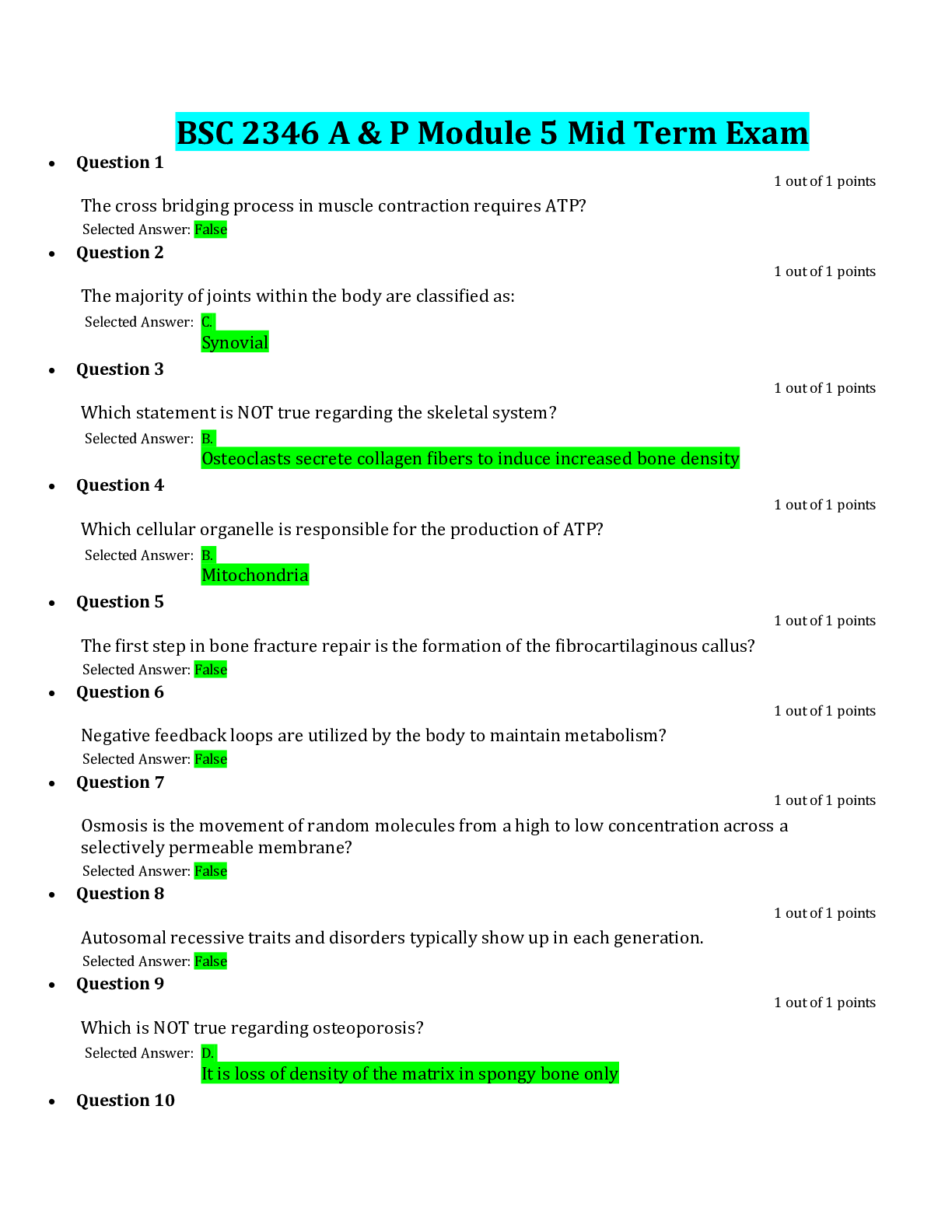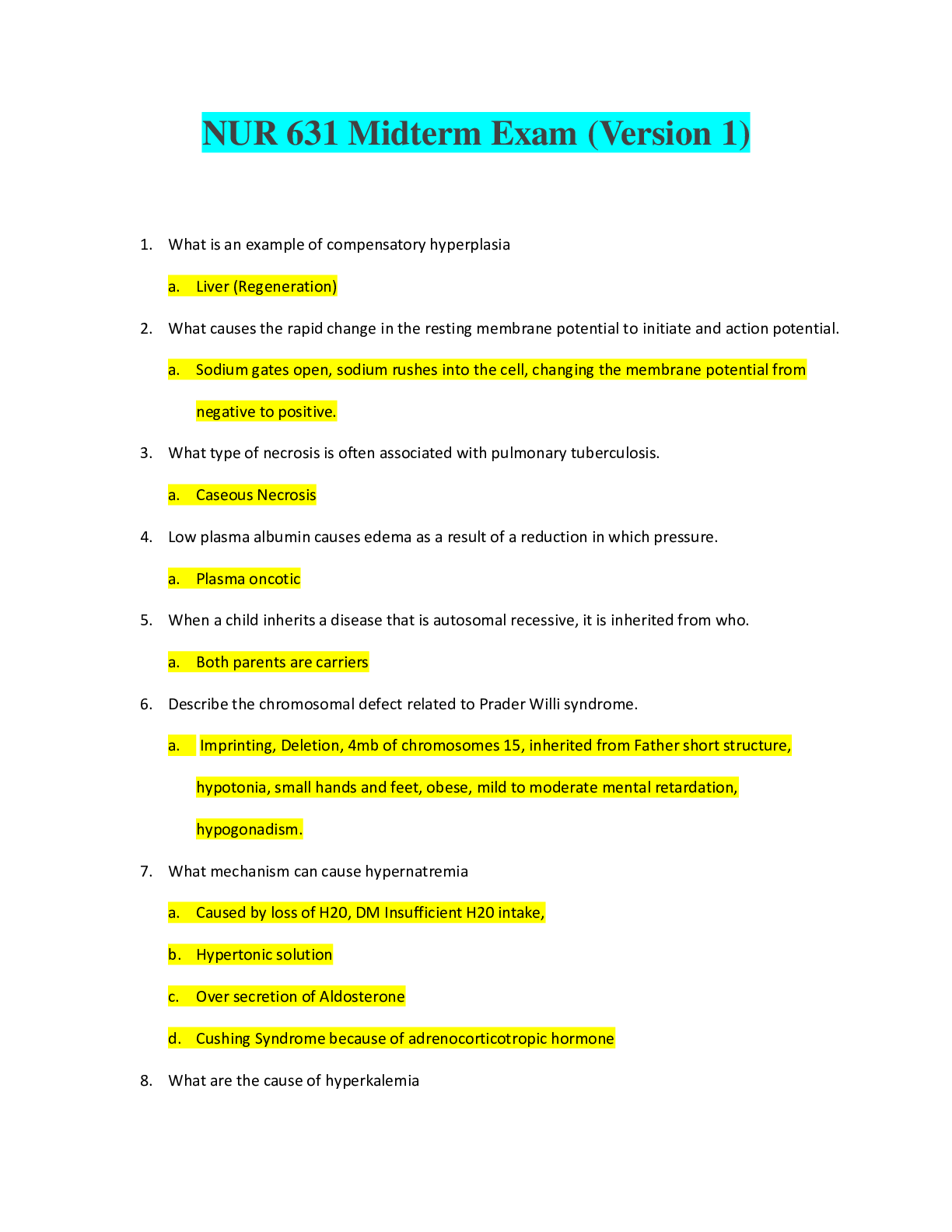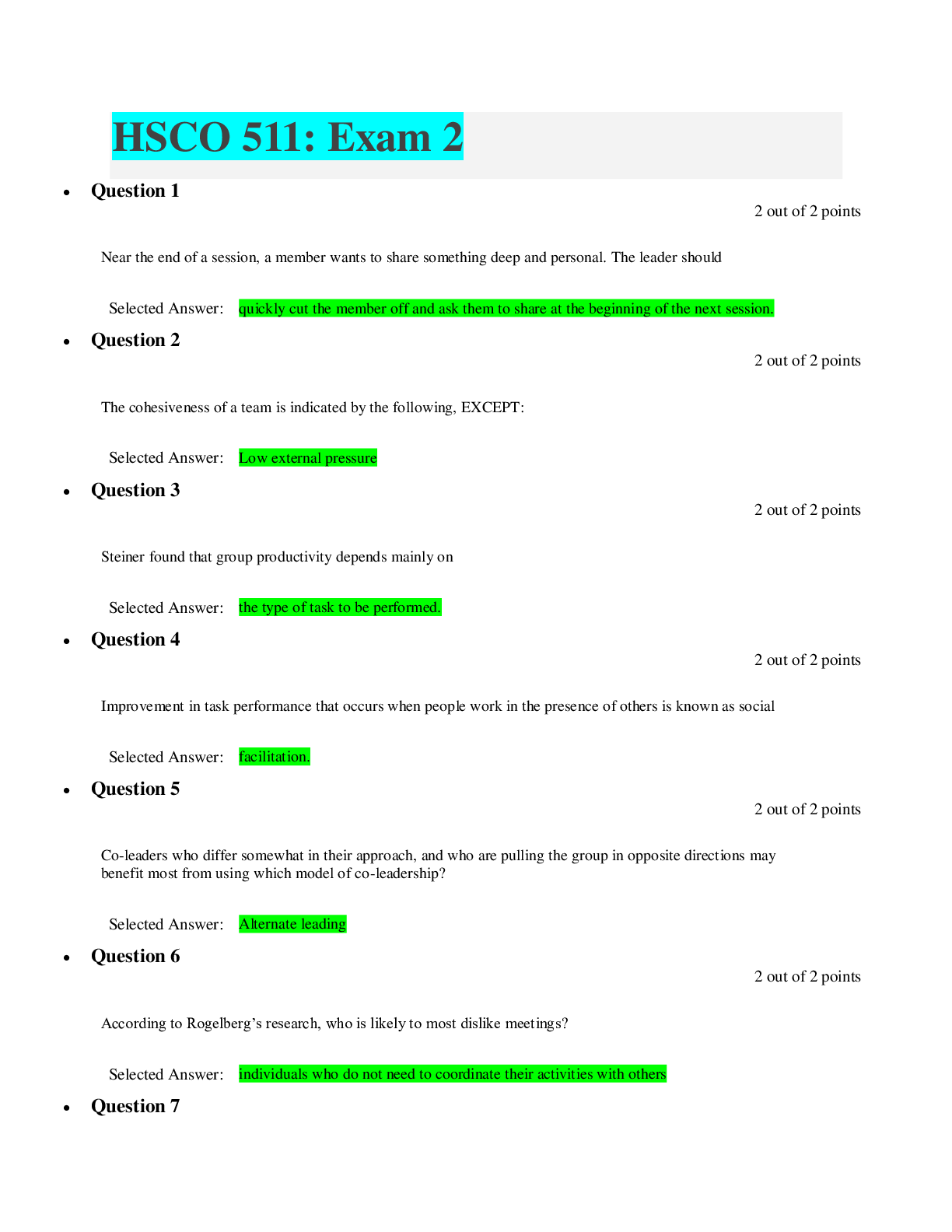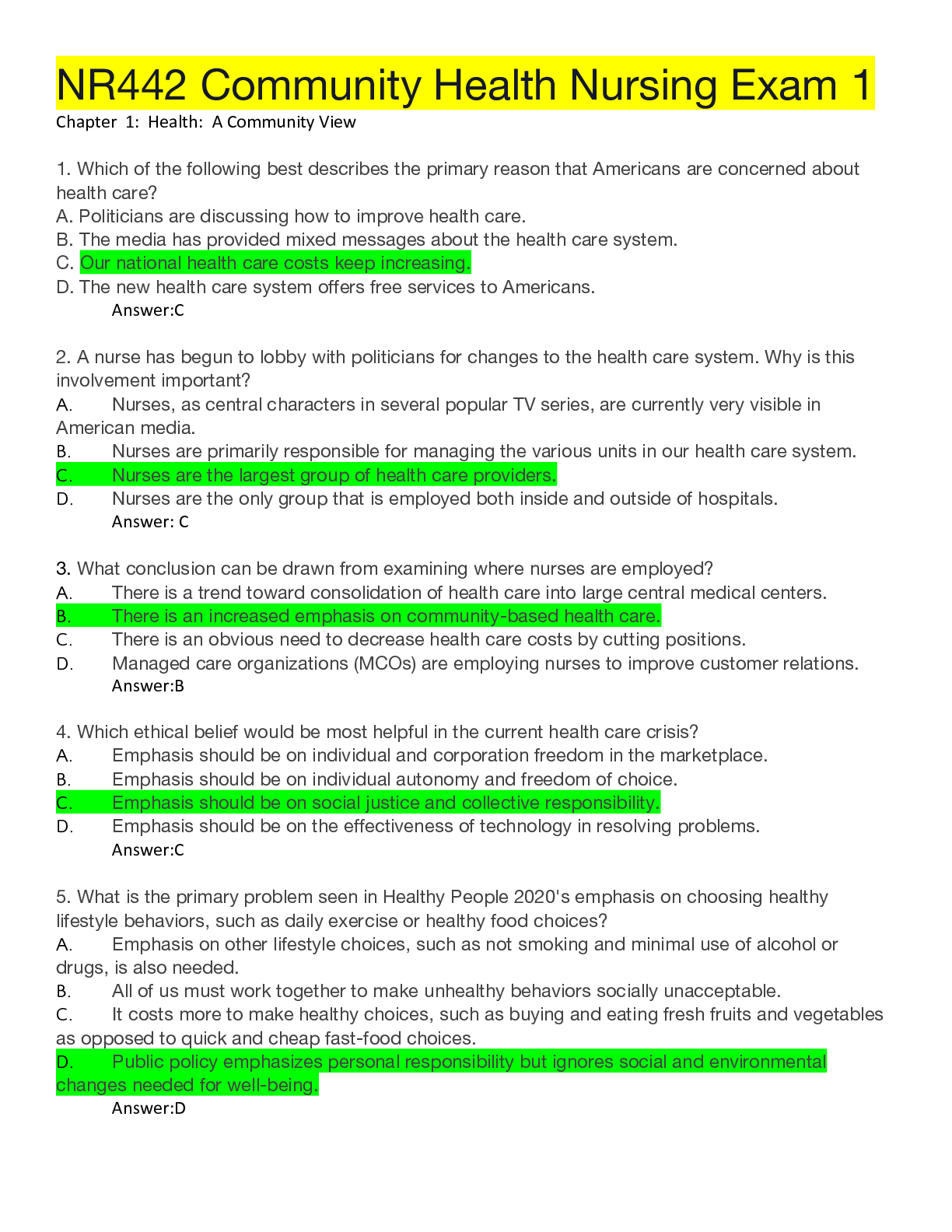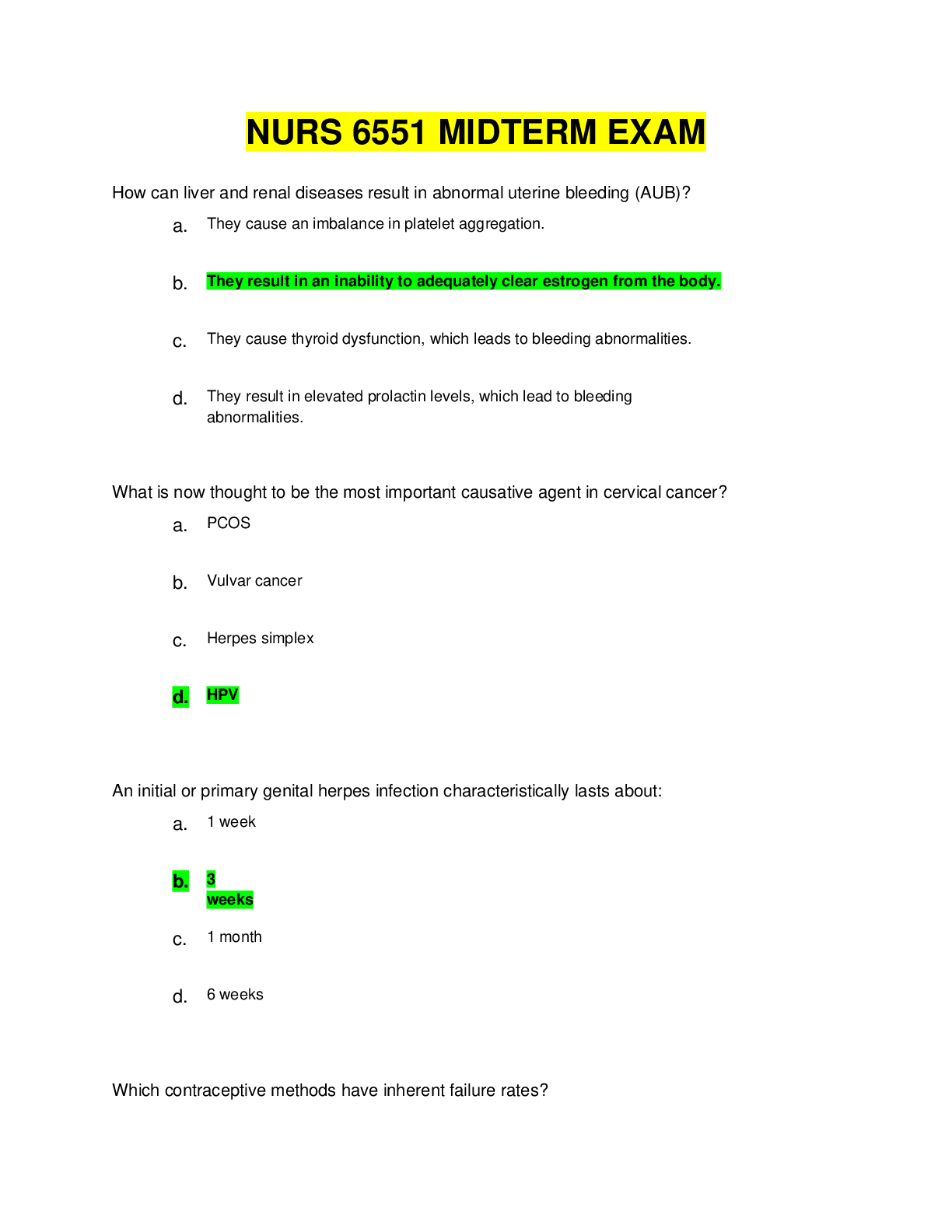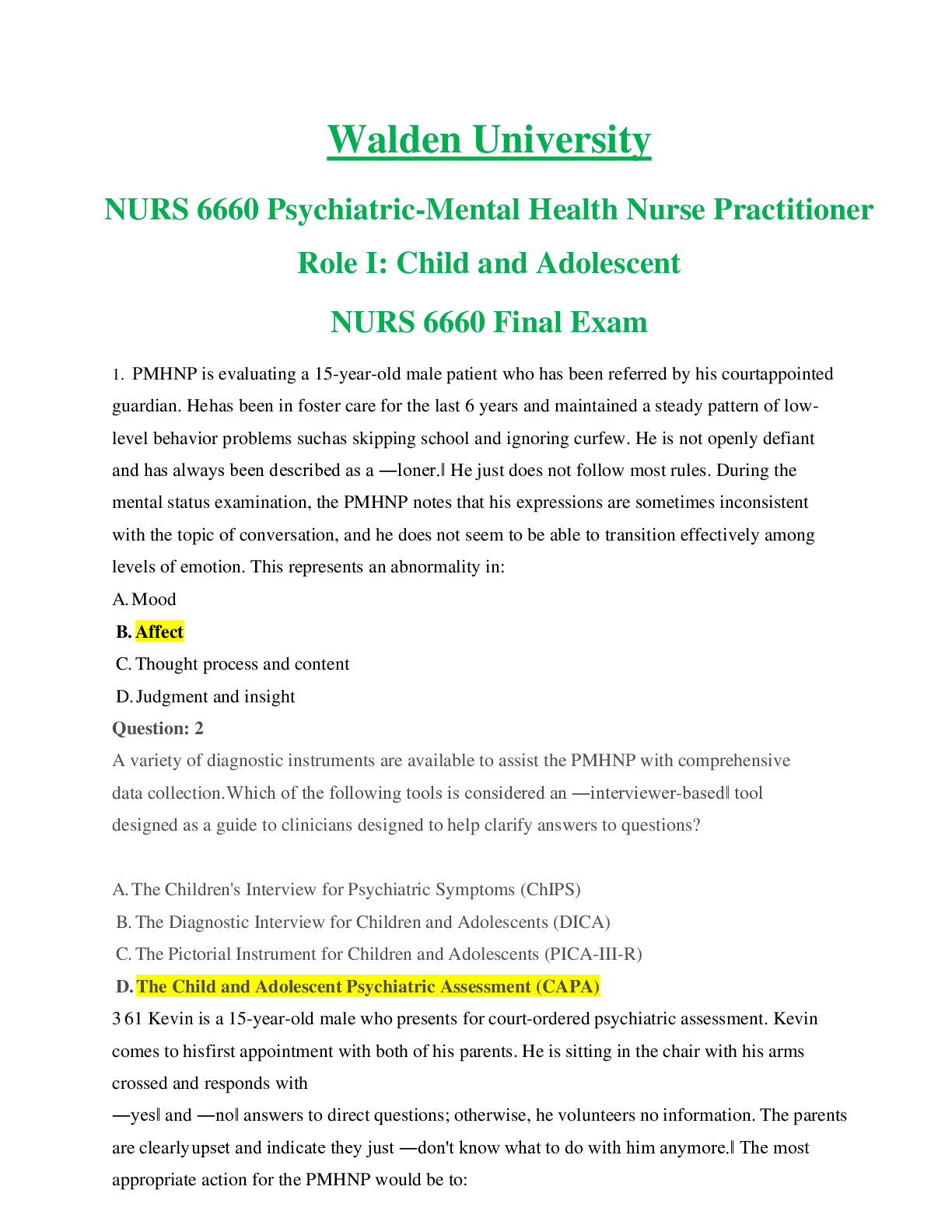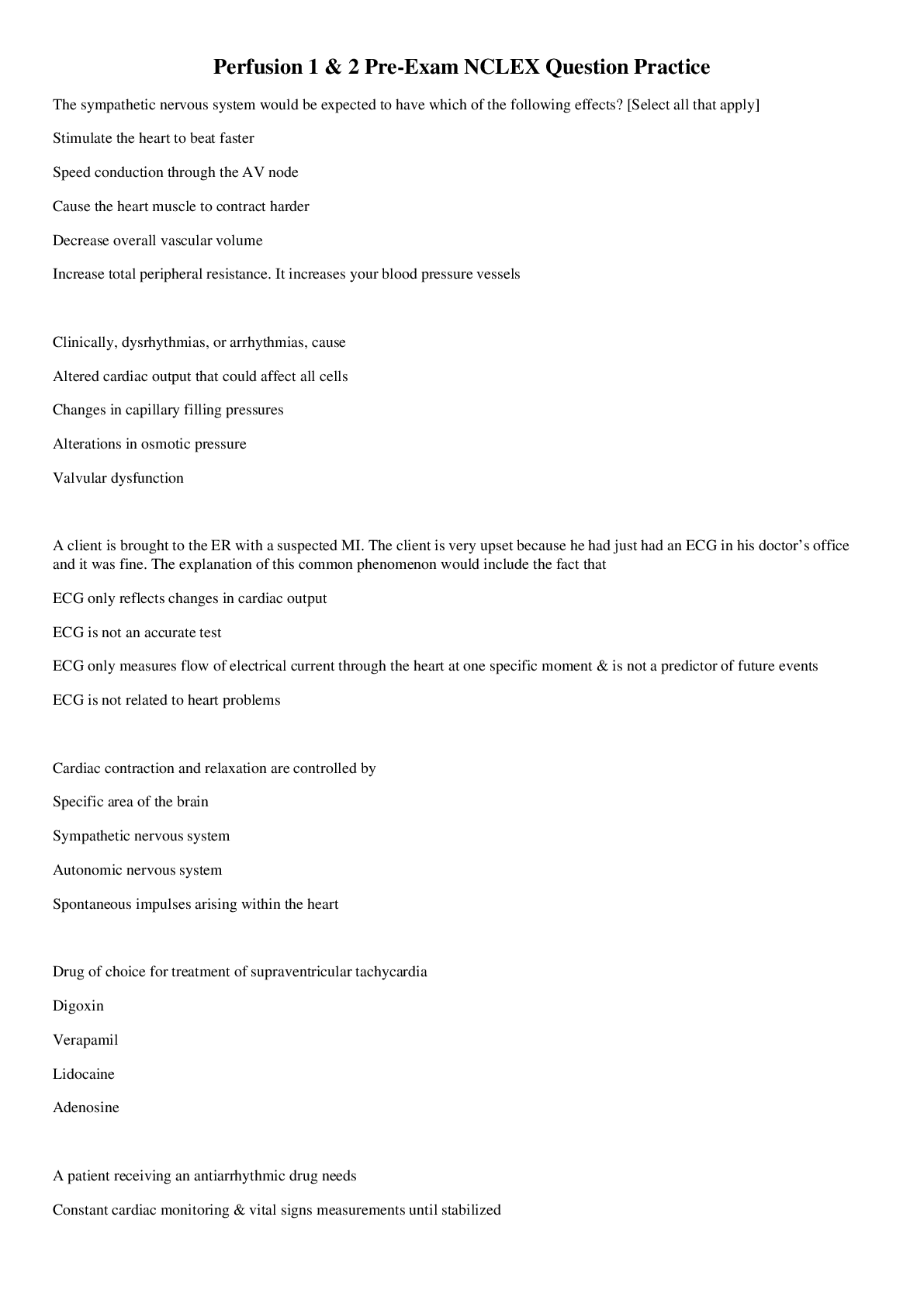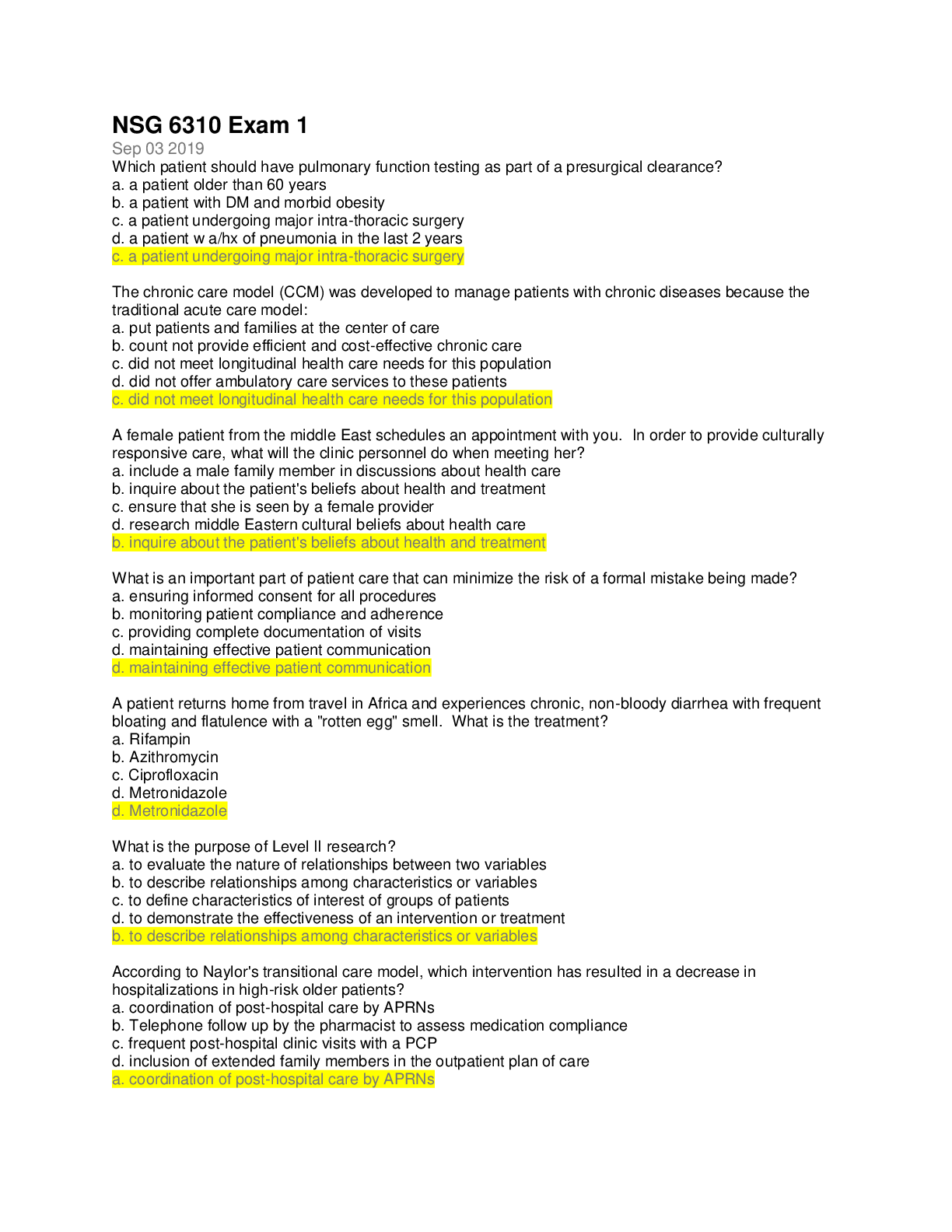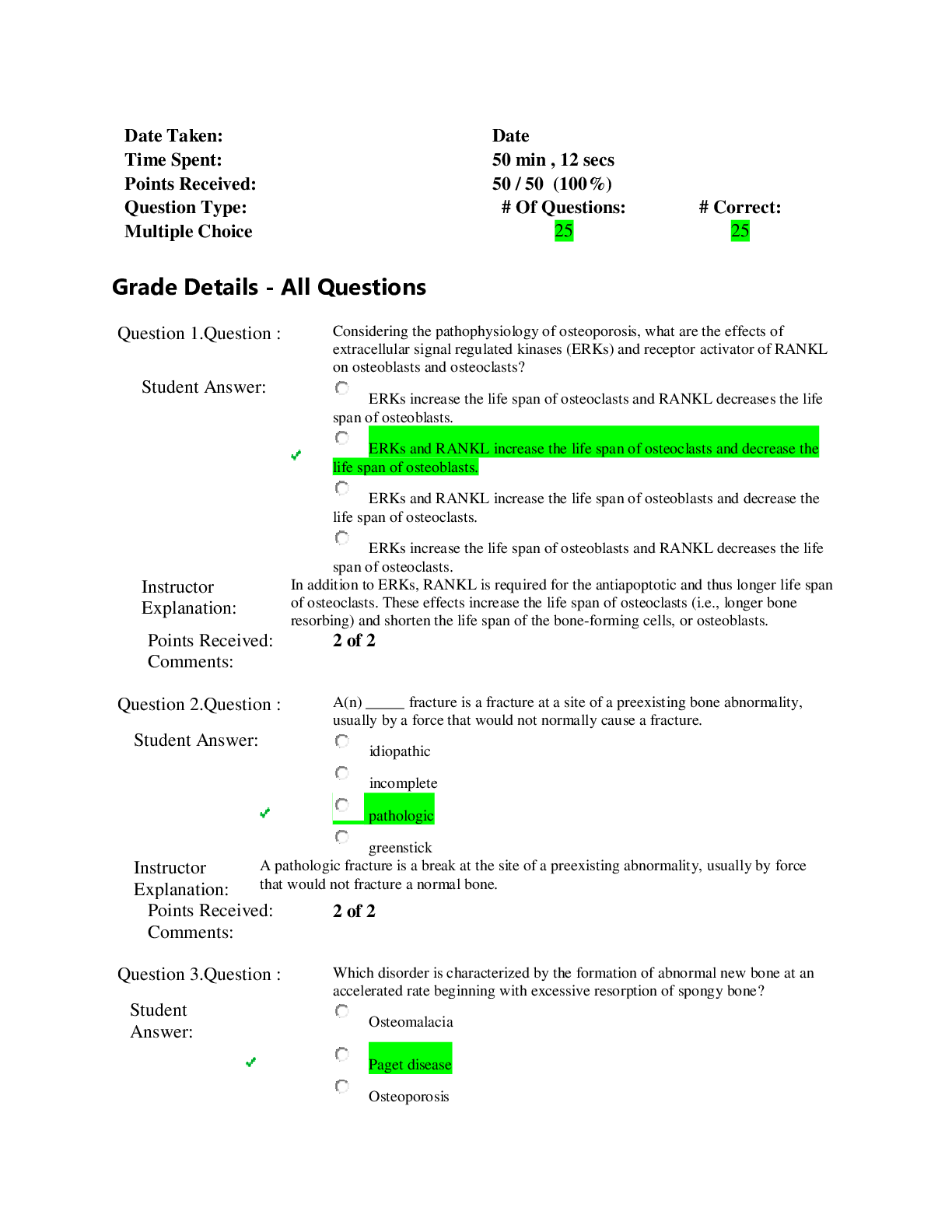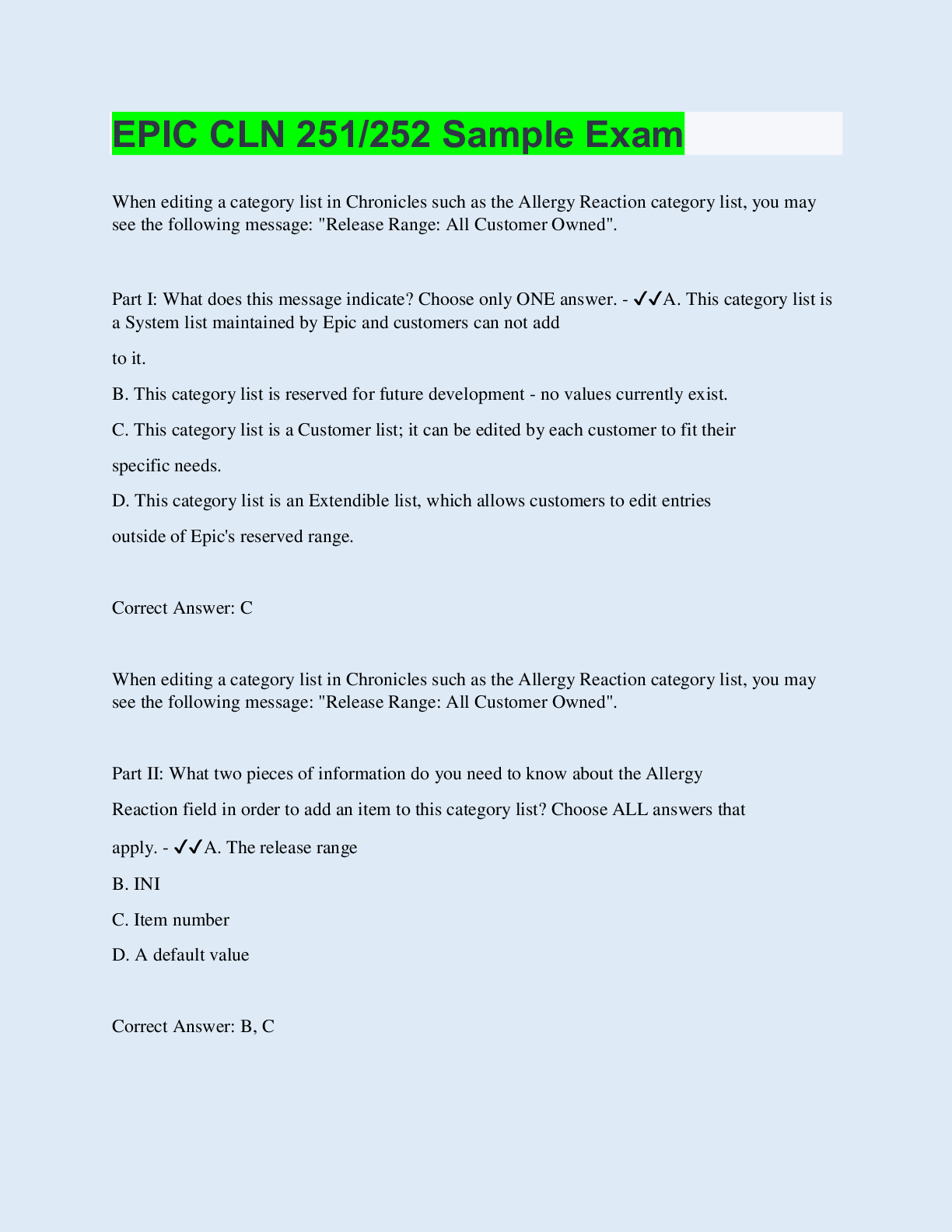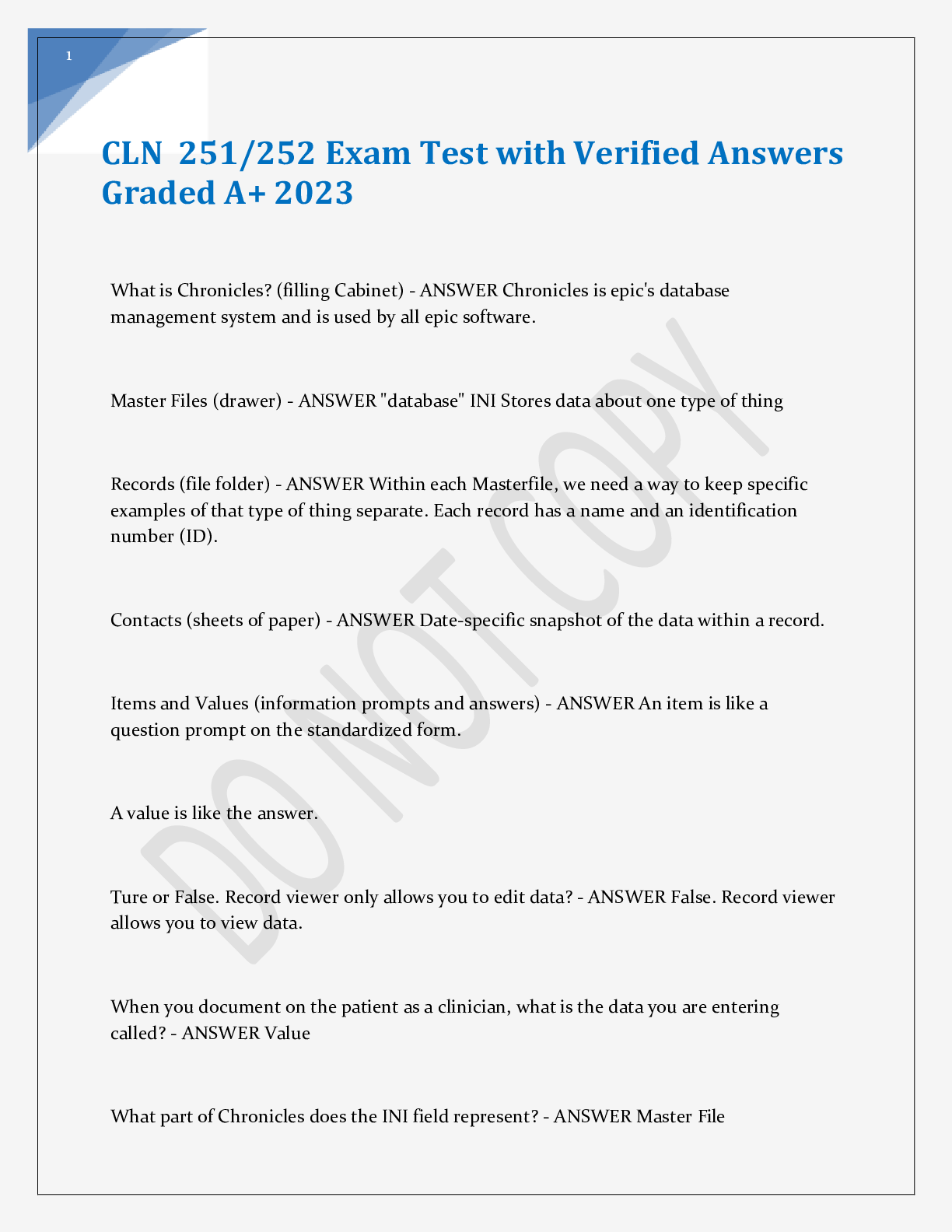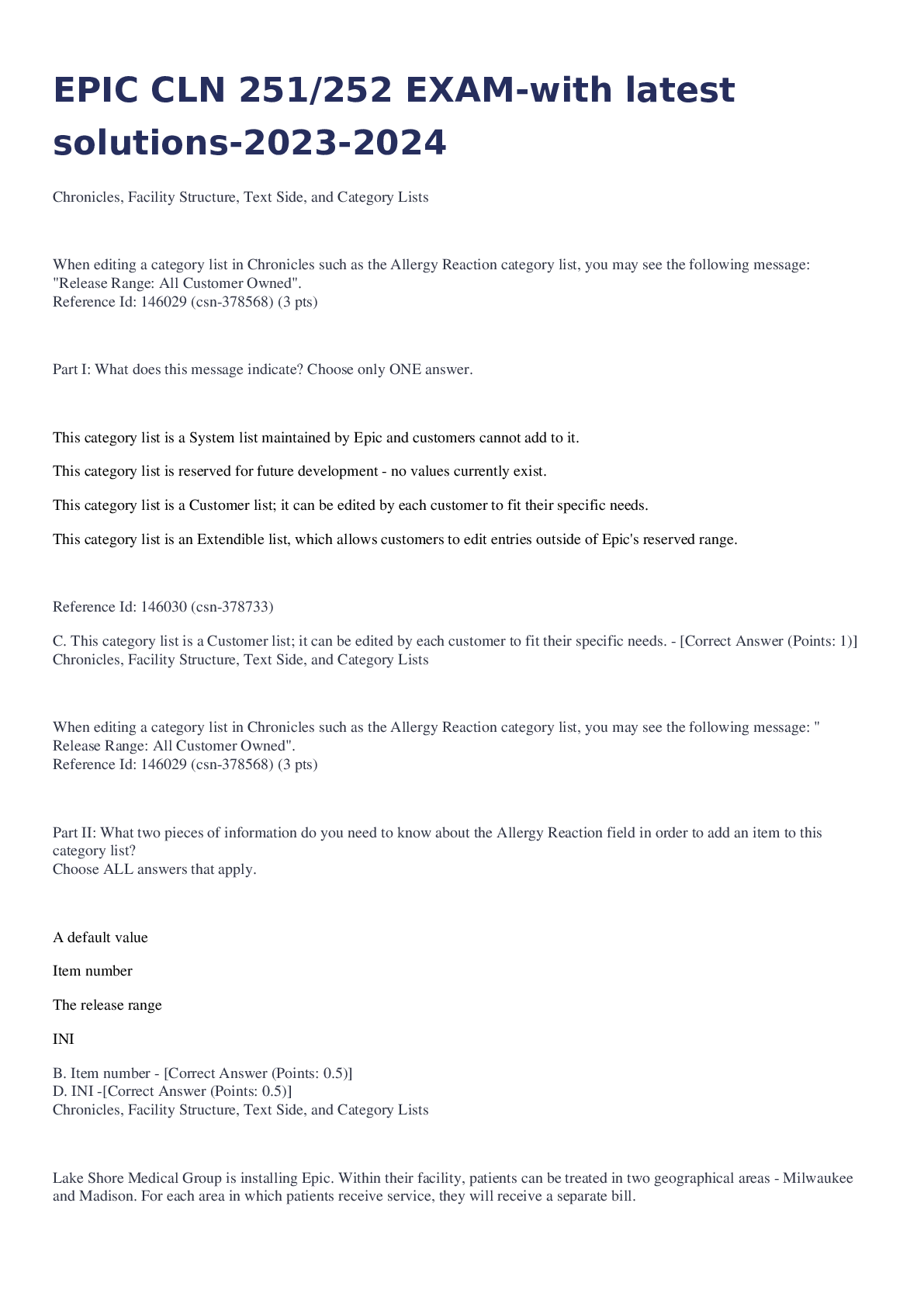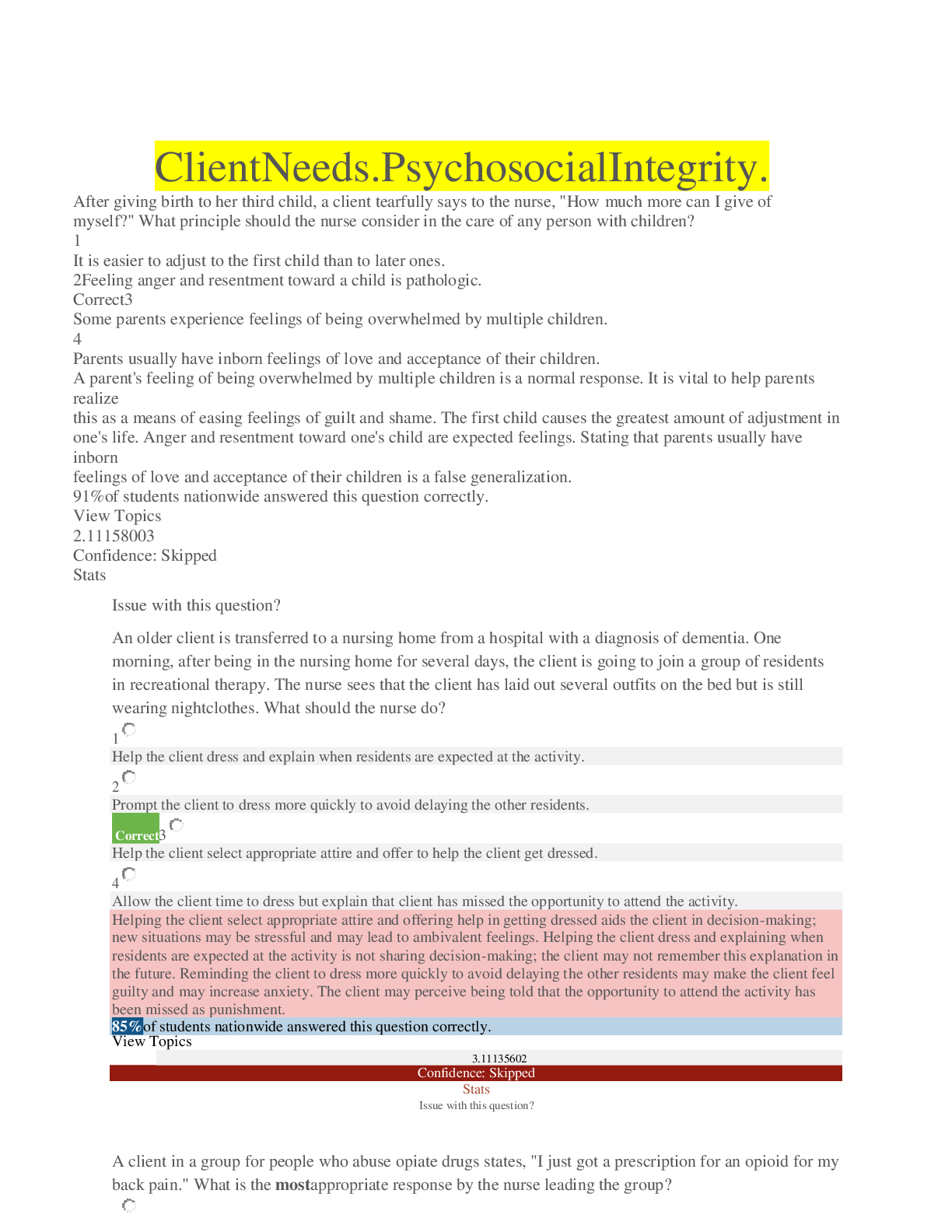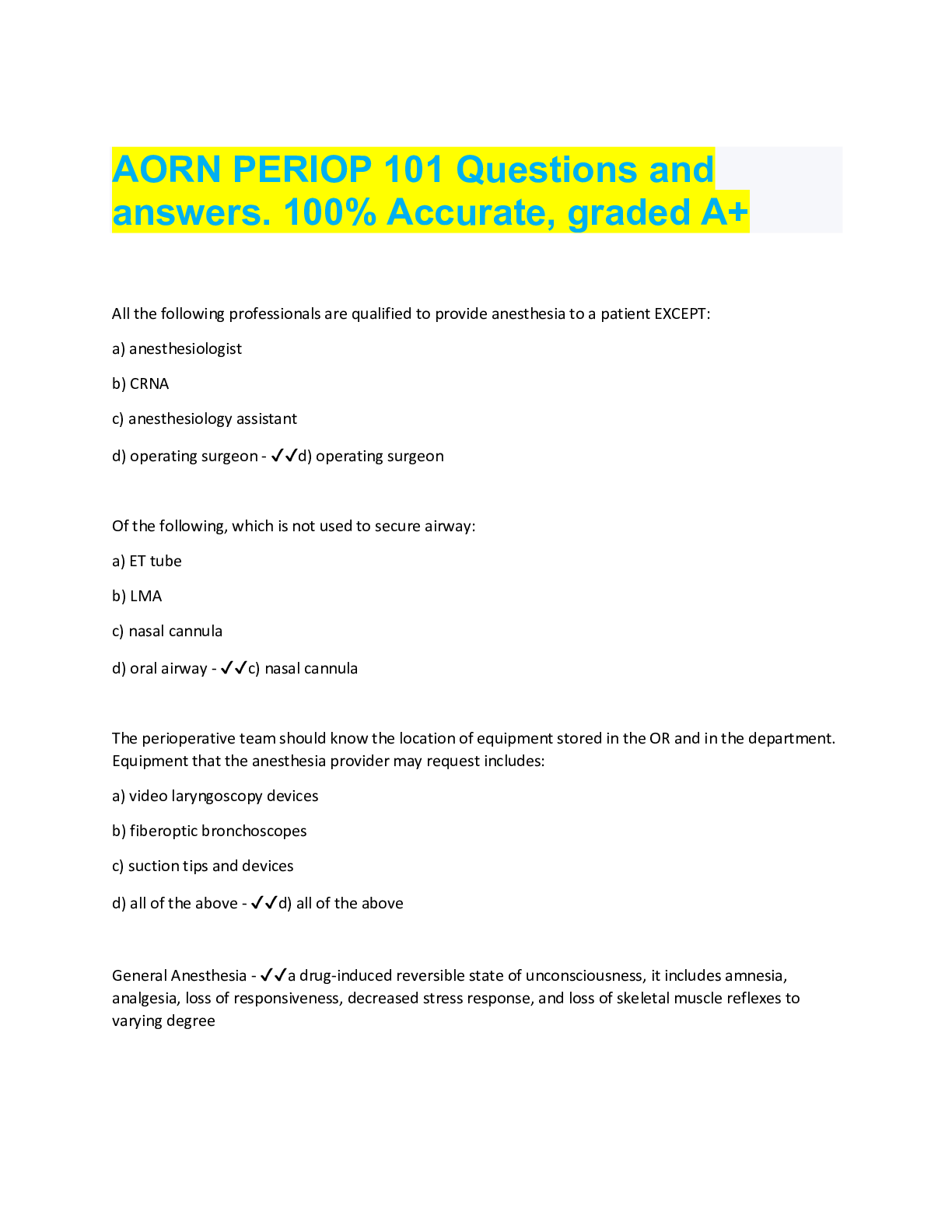Education > EXAM > University Of Florida NSG 5003 Week 3quiz chapters 4-6 and 11-14– Question and Answers,(Already G (All)
University Of Florida NSG 5003 Week 3quiz chapters 4-6 and 11-14– Question and Answers,(Already Graded a clean A)
Document Content and Description Below
Chapter 4: Genes and Genetic Diseases MULTIPLE CHOICE 1. Inserting bone marrow cells into an individual who produces abnormal erythrocytes is an example of what type of therapy? a. Somatic cel... l c. Genetic engineering b. Germ cell d. Recombinant DNA A Gene therapy can be applied in two ways. The less controversial approach is somatic cell therapy, which consists of inserting normal genes into the cells of an individual who has a genetic disease. In this approach, a particular tissue, such as bone marrow cells that produce abnormal erythrocytes, is treated. The correct option is the only one that accurately identifies the therapy described in the question. PTS: 1 REF: Page 137 | Box 4-2 2. DNA replication requires the enzyme DNA polymerase to: a. Travel along the single DNA strand, adding the correct nucleotide to the new strand b. Move along the double strand of DNA to unwind the nucleotides of the double helix c. Hold the double strand apart while the correct nucleotides are added to the strand d. Transport the double strand of DNA from the nucleus to the cytoplasm for protein formation A The DNA polymerase enzyme travels along the single DNA strand, adding the correct nucleotides to the free end of the new strand (see Figure 4-2, B). The correct option is the only one that accurately describes the process involved in DNA replication using DNA polymerase. PTS: 1 REF: Page 137 3. Transcription is best defined as a process by which: a. DNA polymerase binds to the promoter site on ribonucleic acid (RNA). b. RNA directs the synthesis of polypeptides for protein synthesis. c. RNA is synthesized from a DNA template. d. A base pair substitution results in a mutation of the amino acid sequence. C Transcription is the process by which RNA is synthesized from a DNA template. The correct option is the only one that accurately defines the term transcription. PTS: 1 REF: Page 141 4. The purpose of a staining technique of chromosomes such as Giemsa is to: a. Permit the mitotic process to be followed and monitored for variations. b. Allow for the numbering of chromosomes and the identification of variations. c. Identify new somatic cells formed through mitosis and cytokinesis. d. Distinguish the sex chromosomes from the homologous chromosomes. B One of the most commonly used stains is Giemsa stain. By using banding techniques, chromosomes can be unambiguously numbered, and individual variation in chromosome composition can be studied. Missing or duplicated portions of chromosomes, which often result in serious diseases, also can be readily identified. The correct option is the only one that accurately describes the purpose of the Giemsa staining technique. PTS: 1 REF: Pages 142-143 5. An amniocentesis indicates a neural tube defect when an increase in which protein is evident? a. Chorionic c. Amniotic b. Alpha fetoprotein d. Embryonic B Other disorders can be detected with this procedure. These include most neural tube defects, which cause an elevation of alpha fetoprotein in the amniotic fluid, and hundreds of diseases caused by mutations of single genes. The correct option is the only one that accurately identifies the protein responsible for a neural tube defect. PTS: 1 REF: Page 136 | Box 4-1 6. An amniocentesis is recommended for pregnant women who: a. Have a history of chronic illness b. Have a family history of genetic disorders c. Have experienced in vitro fertilization d. Had a late menarche B Amniocentesis is recommended only for pregnancies known to have an elevated risk for a genetic disease or in women older than 30 to 35 years of age. The correct option is the only one that accurately describes a criterion for ordering an amniocentesis. PTS: 1 REF: Page 136 | Box 4-1 7. The most clinically useful technique for prenatal diagnosis of chromosomal abnormalities at 3 months’ (12 weeks’) gestation is: a. Gene mapping c. Amniocentesis b. Linkage analysis d. Chorionic villus sampling D Chorionic villus sampling consists of extracting a small amount of villous tissue directly from the chorion. This procedure can be performed at 10 weeks’ gestation and does not require in vitro culturing of cells; sufficient numbers are directly available in the extracted tissue. Thus the procedure allows prenatal diagnosis at approximately 3 months’ gestation rather than at nearly 5 months’ gestation. The correct option is the only one that accurately describes the most useful technique for prenatal diagnosis of chromosomal abnormalities. PTS: 1 REF: Page 136 | Box 4-1 8. The term for an error in which homologous chromosomes fail to separate during meiosis or mitosis is: a. Aneuploidy c. Polyploidy b. Nondisjunction d. Translocation B Aneuploidy is usually the result of nondisjunction, an error in which homologous chromosomes or sister chromatids fail to separate normally during meiosis or mitosis. The correct option is the only one that is used to describe an error in chromosomal separation during reproduction. PTS: 1 REF: Page 145 9. Which clinical manifestations would be expected for a child who has complete trisomy of the twenty-first chromosome? a. Widely spaced nipples, reduced carrying angle at the elbow, and sparse body hair b. An IQ of 25 to 70, low nasal bridge, protruding tongue, and flat, low-set ears c. High-pitched voice, tall stature, gynecomastia, and an IQ of 60 to 90 d. Circumoral cyanosis, edema of the feet, short stature, and mental slowness B Individuals with this disease are mentally retarded, with IQs usually ranging from 25 to 70. The facial appearance is distinctive and exhibits a low nasal bridge, epicanthal folds (which produce a superficially Asian appearance), protruding tongue, and flat, low-set ears. The correct option is the only one that accurately describes the clinical manifestations of the complete trisomy of the twenty-first chromosome. PTS: 1 REF: Pages 146-147 10. What is the most common cause of Down syndrome? a. Paternal nondisjunction c. Maternal nondisjunction b. Maternal translocations d. Paternal translocation C Nondisjunction during the formation of one of the parent’s gametes or during early embryonic development occurs in approximately 97% of infants born with Down syndrome. In approximately 90% to 95% of infants, the nondisjunction occurs in the formation of the mother’s egg cell. The correct option is the only one that accurately describes the most common cause of Down syndrome. PTS: 1 REF: Page 147 11. What syndrome, characterized by an absent homologous X chromosome with only a single X chromosome, exhibits features that include a short stature, widely spaced nipples, and webbed neck? a. Down c. Turner b. Cri du chat d. Klinefelter C In Turner syndrome, a sex chromosome is missing, and the person’s total chromosome count is 45. Characteristic signs include short stature, female genitalia, webbed neck, shieldlike chest with underdeveloped breasts and widely spaced nipples, and imperfectly developed ovaries. The correct option is the only one that accurately describes the clinical manifestations described in the question. PTS: 1 REF: Page 147 12. A person with 47, XXY karyotype has the genetic disorder resulting in which syndrome? a. Turner c. Down b. Klinefelter d. Fragile X B A disorder in the chromosome (47, XXY karyotype) results in a disorder known as Klinefelter syndrome. The correct option is the only one that accurately describes a genetic disorder that exhibits the described genetic configuration. PTS: 1 REF: Page 148 13. What is the chromosomal variation that causes Klinefelter syndrome? a. Nondisjunction of the X chromosome in the father b. Translocation of the X chromosome in the mother c. Nondisjunction of X chromosome in the mother d. Translocation of the Y chromosome in the father C Nondisjunction of the X chromosomes in the mother causes Klinefelter syndrome in the majority of infants, and the frequency of the disorder rises with maternal age. The correct option is the only one that accurately describes the chromosomal variation characteristic of Klinefelter syndrome. PTS: 1 REF: Page 148 14. What is the second most commonly recognized genetic cause of mental retardation? a. Down syndrome c. Klinefelter syndrome b. Fragile X syndrome d. Turner syndrome B The fragile X syndrome is the second most common genetic cause of mental retardation (after Down syndrome). The correct option is not observed with enough frequency to be recognized as the second most common cause of mental retardation. PTS: 1 REF: Page 151 15. What is the blood type of a person who is heterozygous, having A and B alleles as codominant? a. A c. O b. B d. AB D When the heterozygote is distinguishable from both homozygotes, the locus is said to exhibit codominance. An example is the ABO blood group, in which heterozygotes having the A and B alleles express both of them as A and B antigens on their red cells (forming blood group AB). The correct option is the only one that accurately describes codominance. PTS: 1 REF: Page 151 16. A couple has two children diagnosed with an autosomal dominant genetic disease. What is the probability that the next child will have the same genetic disease? a. One sixth c. One third b. One fourth d. One half D Affected heterozygous individuals transmit the trait to approximately one half of their children; however, because gamete transmission is subject to chance fluctuations, it is possible that all or none of the children of an affected parent may have the trait. Nevertheless, when large numbers of matings of this type are studied, the proportion of affected children closely approach one half. PTS: 1 REF: Pages 152-153 17. When a child inherits a disease that is autosomal recessive, it is inherited from: a. Father c. Both parents b. Mother d. Grandparent C In most cases of recessive disease, both parents of affected individuals are heterozygous carriers. PTS: 1 REF: Pages 155-156 18. People diagnosed with neurofibromatosis have varying degrees of the condition because of the genetic principle of: a. Penetrance c. Dominance b. Expressivity d. Recessiveness B Expressivity is the extent of variation in phenotype associated with a particular genotype. If expressivity of a disease is variable, then the penetrance may be complete but the severity of the disease can vary greatly. A well-known example of variable expressivity in an autosomal dominant disease is type 1 neurofibromatosis. The correct option is the only one that accurately describes the presence of varying degrees of symptomatologic characteristics. PTS: 1 REF: Page 154 19. Which genetic disease has been linked to a mutation of the tumor-suppressor gene? a. Hemochromatosis c. Familial breast cancer b. Retinoblastoma d. Hemophilia A B The gene responsible for retinoblastoma has been mapped to the long arm of chromosome 13, and its DNA sequence has been extensively studied. This gene is known as a tumor-suppressor gene; the normal function of its protein product is to regulate the cell cycle so that cells do not grow uncontrollably. The correct option is the only one that accurately identifies a disease resulting from a mutation of the tumor-suppressor gene. PTS: 1 REF: Page 154 20. Cystic fibrosis is caused by what type of gene? a. X-linked dominant c. Autosomal dominant b. X-linked recessive d. Autosomal recessive D The most common lethal autosomal recessive disease in white children, cystic fibrosis, occurs in approximately 1 in 2500 births. The correct option is the only one that accurately identifies the gene type responsible for cystic fibrosis. PTS: 1 REF: Page 154 21. Which is an important criterion for discerning autosomal recessive inheritance? a. Consanguinity is sometimes present. b. Females are affected more than males. c. The disease is observed in both the parents, as well as in the siblings. d. On average, one half of the offspring of the carrier will be affected. A Consanguinity is often an important characteristic of pedigrees for recessive diseases; relatives share a certain proportion of genes received from a common ancestor. The correct option is the only one that accurately identifies a required factor in autosomal recessive genetic inheritance. PTS: 1 REF: Page 155 22. Consanguinity refers to the mating of persons: a. Who are unrelated b. When one has an autosomal dominant disorder c. Having common family relations d. When one has a chromosomal abnormality C Consanguinity refers to the mating of two related individuals, and the offspring of such matings are said to be inbred. The correct option is the only one that accurately identifies consanguinity as it relates to human mating. PTS: 1 REF: Page 155 23. Males, having only one X chromosome (as is expected), are said to be: a. Homozygous c. Hemizygous b. Heterozygous d. Ambizygous C Males, having only one X chromosome, are said to be hemizygous for genes on this chromosome. The correct option is the only one that accurately identifies the term for males having only one X chromosome. PTS: 1 REF: Page 156 24. Males are more often affected by which type of genetic disease? a. Sex-linked dominant c. Sex-linked b. Sex-influenced d. Sex-linked recessive D Males are more frequently affected by X-linked recessive diseases, with the difference becoming more pronounced as the disease becomes rarer. The correct option is the only one that is a characteristic of a male-dominate disease. PTS: 1 REF: Page 156 25. An X-linked recessive disease can skip generations because: a. Females are hemizygous for the X chromosome. b. The disease can be transmitted through female carriers. c. Mothers cannot pass X-linked genes to their sons. d. These diseases need only one copy of the gene in females. B Skipped generations are often observed in X-linked recessive disease pedigrees because the gene can be transmitted through female carriers. Males are hemizygous for genes on the X chromosome. Fathers cannot pass X-linked genes to their sons. X-linked recessive diseases are observed significantly more often in males than in females, because males need only one copy of the gene to express the disease. PTS: 1 REF: Page 157 26. The presence of a zygote having one chromosome with the normal complement of genes and one with a missing gene is characteristic of which genetic disorder? a. Cri du chat c. Klinefelter syndrome b. Down syndrome d. Turner syndrome A This description is only accurate for Cri du chat syndrome. PTS: 1 REF: Pages 148-149 27. A child with which genetic disorder has a characteristic cry? a. Down syndrome c. Turner syndrome b. Klinefelter syndrome d. Cri du chat D Cri du chat, which literally means “cry of the cat,” describes the characteristic cry of the affected child. The correct option is the only one with the characteristic cry. PTS: 1 REF: Page 148 28. Which statement is true regarding X-linked recessive conditions? a. Such diseases use males as phenotypical carriers. b. These conditions are passed from affected father to all of his female children. c. 25% of an affected individual’s grandsons will be affected. d. Cystic fibrosis is an example of such a condition. B X-linked recessive conditions are passed from an affected father to all of his daughters, who, as phenotypically normal carriers, transmit it to approximately one half of their sons, who are affected. Cystic fibrosis is an autosomal dominant disease. PTS: 1 REF: Page 158 29. DNA formation occurs in which of the cell’s structures? a. Nucleus c. Organelle b. Cytoplasm d. Membrane A DNA is formed and replicated only in the cell nucleus. PTS: 1 REF: Pages 135-141 30. What is the risk for the recurrence of autosomal dominant diseases? a. 10% c. 50% b. 30% d. 70% C The recurrence risk for autosomal dominant diseases is usually 50%. PTS: 1 REF: Pages 152-153 31. An individual’s genetic makeup is referred to as his or her: a. Phenotype c. Heterozygous locus b. Genotype d. Homozygous locus B An individual’s genotype is his or her genetic makeup. The correct option is the only one that accurately defines a person’s genetic makeup. PTS: 1 REF: Page 151 MULTIPLE RESPONSE 32. Which disorders have similar modes of inheritance? (Select all that apply.) a. Cri du chat syndrome b. Duchenne muscular dystrophy c. Polycystic kidney disease d. Down syndrome e. Becker muscular dystrophy B, E Becker muscular dystrophy and Duchenne muscular dystrophy are the only options that are X-linked recessive disorders. PTS: 1 REF: Page 158 33. The key to accurate DNA replication depends on which complementary base pairs? (Select all that apply.) a. Adenine with thymine b. Adenine with guanine c. Guanine with cytosine d. Cytosine with thymine e. Guanine with thymine A, C The consistent pairing of adenine with thymine and of guanine with cytosine, known as complementary base pairing, is the key to accurate DNA replication. The correct options are the only ones that accurately identify complementary base pairs. PTS: 1 REF: Page 137 34. Chromosomal abnormalities are the leading known cause of: (Select all that apply.) a. Mental illness b. Mental retardation c. Fetal miscarriage d. Cardiovascular disease e. Respiratory disorders B, C Chromosome abnormalities are the leading known cause of mental retardation and miscarriage. The correct options are the only ones that accurately identify disorders that related to chromosomal abnormalities. PTS: 1 REF: Page 143 35. Examples of prenatal diagnostic studies include: (Select all that apply.) a. Chorionic villus sampling (CVS) b. Amniocentesis c. Carrier screening d. Preimplantation genetic diagnosis (PGD) e. Drug-sensitivity testing A, B, D Prenatal testing is conducted before or during the pregnancy but not once labor begins. Such diagnostic studies include amniocenteses, CVS, and PGD. The correct options are the only ones that are exclusively used during the prenatal period. PTS: 1 REF: Page 136 | Box 4-1 36. The advantage derived from human genome sequencing on genetic disorders focuses on: (Select all that apply.) a. Identification of the mutated gene b. Reversal of the mutation c. Diagnosis of the existing disorder d. Appropriate treatment e. Prevention of the disorder A, C, D The complete human genome sequence will facilitate gene identification, diagnosis, and disease treatment. The reversal of a mutation is not possible. The mapping has no effect on preventing a genetic disorder. PTS: 1 REF: Page 160 MATCHING Match the genetic terms with the corresponding diseases. Terms may be used more than once. ______ A. Autosomal dominant ______ B. Autosomal recessive ______ C. X-linked dominant ______ D. X-linked recessive 37. Cystic fibrosis 38. Duchenne muscular dystrophy 39. Sickle cell disease 40. Huntington disease 37. B PTS: 1 REF: Page 154 MSC: Is an important example of an autosomal recessive disease is cystic fibrosis. 38. D PTS: 1 REF: Page 158 MSC: Is an important example of an X-linked recessive disease is Duchenne muscular dystrophy. 39. B PTS: 1 REF: Page 136 | Box 4-1 MSC: Is an important example of an autosomal recessive disease is sickle cell disease. 40. A PTS: 1 REF: Page 154 MSC: Another well-known autosomal dominant disease is Huntington disease. Chapter 5: Genes, Environment-Lifestyle, and Common Diseases MULTIPLE CHOICE 1. The data reporting that sickle cell disease affects approximately 1 in 600 American blacks is an example of which concept? a. Incidence c. Ratio b. Prevalence d. Risk B Prevalence rate is the proportion of the population affected by a disease at a specific point in time. Thus both the incidence rate and the length of the survival period in affected individuals determine prevalence. The incidence rate is the number of new cases of a disease reported during a specific period (typically 1 year), divided by the number of individuals in the population. A numerical expression representing a part of a larger whole or proportion is considered a ratio. Any factor that increases the chance of disease or injury is considered a risk. PTS: 1 REF: Page 165 2. The ratio of the disease among the exposed population to the disease rate in an unexposed population is referred to as what type of risk? a. Attributable c. Causal b. Contingency d. Relative D A common measure of the effect of a specific risk factor is the relative risk. Assuming a factor is the cause of a disease, attributable risk is the amount of risk that is due to that factor. A future event or circumstance that is possible but cannot be predicted with certainty is a contingency risk. The probability of the outcome is termed a causal risk factor. PTS: 1 REF: Page 165 3. Empirical risks for most multifactorial diseases are based on: a. Chromosomal testing c. Liability thresholds b. Direct observation d. Relative risks B For most multifactorial diseases, empirical risks (i.e., risks based on direct observation of data) have been derived. The other options are not the basis for determining the empirical risk of most multifactorial diseases. PTS: 1 REF: Page 167 4. What is the cause of familial hypercholesterolemia (FH)? a. Diet high in saturated fats b. Increased production of cholesterol by the liver c. Reduction in the number of low-density lipoprotein (LDL) receptors on cell surfaces d. Abnormal function of lipoprotein receptors circulating in the blood C A reduction in the number of functional LDL receptors on cell surfaces causes FH. Lacking the normal number of LDL receptors, cellular cholesterol uptake is reduced and circulating cholesterol levels increase (see Box 5-3). The other options are not the basis for developing familial FH. PTS: 1 REF: Page 173 | Box 5-3 5. Which risk factor for hypertension is influenced by genetic factors and lifestyle? a. Sodium intake c. Psychosocial stress b. Physical inactivity d. Obesity D The most important environmental risk factors for hypertension are increased sodium intake, decreased physical activity, psychosocial stress, and obesity. However, obesity is, itself, influenced by genes and the environment. PTS: 1 REF: Page 172 6. What percentage of all cases of breast cancer are identified as an autosomal dominant form? a. 5 c. 15 b. 10 d. 20 A An autosomal dominant form of breast cancer accounts for approximately 5% of breast cancer cases in the United States. PTS: 1 REF: Page 172 | Page 174 7. When a woman has one first-degree relative with breast cancer, her risk of developing breast cancer is how many times greater? a. 2 c. 6 b. 3 d. 10 A If a woman has one affected first-degree relative, her risk of developing breast cancer doubles. PTS: 1 REF: Page 172 8. Adoption studies have shown that the offspring of an alcoholic parent when raised by nonalcoholic parents have what amount of an increased risk of developing alcoholism? a. Twofold c. Fourfold b. Threefold d. Tenfold C Adoption studies have shown that the offspring of an alcoholic parent, even when raised by nonalcoholic parents, have a fourfold increased risk of developing the disorder. PTS: 1 REF: Page 179 9. Studies have identified several genes that play a role in the prevention of obesity by affecting what? a. Regulation of appetite c. Absorption of fat b. Metabolizing of fat d. Altering the sense of satiety A Clinical trials using recombinant leptin have demonstrated moderate weight loss in a subset of obese individuals. In addition, leptin participates in important interactions with other components of appetite control, such as neuropeptide Y and –melanocyte-stimulating hormone and its receptor, the melanocortin-4 receptor (MC4R). Currently, no research supports the other options as being genetically regulated. PTS: 1 REF: Page 178 10. The BRCA1 and BRCA2 mutations increase the risk of which cancer in women? a. Ovarian c. Uterine b. Lung d. Pancreatic A BRCA1 mutations increase the risk of ovarian cancer among women (20% to 50% lifetime risk), and BRCA2 mutations also confer an increased risk of ovarian cancer (10% to 20% lifetime prevalence). BRCA1 and BRCA2 mutations are not currently believed to be linked with risks of lung, uterine, or pancreatic cancers. PTS: 1 REF: Page 174 11. Blood pressure variations are associated with: a. ß1-adrenergic receptors to increase heart rate b. The release of an antidiuretic hormone (ADH) that increases water reabsorption c. The renin-angiotensin system’s effect on vasoconstriction d. Serum bradykinin, causing vasodilation C Significant research is now focused on specific components that may influence blood pressure variation, such as the renin-angiotensin system (involved in sodium reabsorption and vasoconstriction). The other options are not related to hypertension. PTS: 1 REF: Page 172 12. The two most important risk factors for type 2 diabetes are: a. Autoantibodies and human leukocyte antigen associations b. Autoantibodies and obesity c. Obesity and positive family history d. HLA associations and positive family history C The two most important risk factors for type 2 diabetes are positive family history and obesity. The other options are not believed to be important risk factors for this form of diabetes. PTS: 1 REF: Pages 177-178 13. A major characteristic of type 1 diabetes mellitus is that there is: a. Partial insulin secretion c. Insulin resistance b. An autoimmune cause factor d. Obesity as a common risk factor B A strong association between type 1 diabetes and the presence of several human leukocyte antigen (HLA) class II alleles indicate that type 1 diabetes mellitus is an autoimmune disease. The remaining options are associated with type 2 diabetes. PTS: 1 REF: Page 174 14. Obesity acts as an important risk factor for type 2 diabetes mellitus by: a. Reducing the amount of insulin the pancreas produces b. Increasing the resistance to insulin by cells c. Obstructing the outflow of insulin from the pancreas d. Stimulating the liver to increase glucose production B People with type 2 diabetes mellitus suffer from insulin resistance (i.e., their cells have difficulty using insulin). The other options are not associated with the effect of obesity regarding insulin production. PTS: 1 REF: Pages 177-178 15. Traits caused by the combined effects of multiple genes are referred to by which term? a. Polygenic c. Modifiable b. Multifocal d. Involuntary A Traits in which variation is thought to be caused by the combined effects of multiple genes are polygenic, meaning many genes. Multifocal means relating to or arising from many points. Modifiable refers to the changeability of something. Involuntary suggests being out of the control of someone or something. PTS: 1 REF: Page 165 16. Regarding type 2 diabetes, obesity is considered to be what type of risk? a. Genetic c. Relative b. Empirical d. Modifiable D Obesity is a modifiable risk factor for many diseases including heart disease, stroke, hypertension, and type 2 diabetes. The other terms do not apply. PTS: 1 REF: Pages 177-178 17. Which disease form is identified on the basis of empirical risk observation? a. Polygenic c. Monozygotic b. Multifactorial d. Genetic B For most multifactorial diseases, empirical risks (i.e., risks based on direct observation of data) have been derived. Traits in which variation is thought to be caused by the combined effects of multiple genes are polygenic. Monozygotic is a term that refers to identical twins. Genetic refers to issues related to genes and their influence on the body. PTS: 1 REF: Page 167 18. The number of persons living with a specific disease at a specific point in time is referred to by which term? a. Relativity c. Prevalence b. Survivability d. Incidence C The prevalence rate is the proportion of the population affected by a disease at a specific point in time. Thus both the incidence rate and the length of the survival period in affected individuals determine prevalence. The description in the question does not relate to any of the other options. PTS: 1 REF: Page 164 19. Which type of cancer is said to aggregate among families? a. Breast c. Skin b. Lung d. Brain A Breast cancer appears to aggregate strongly in families. The other cancers are not believed to be familial in nature. PTS: 1 REF: Page 172 20. Which dietary lifestyle choice has been associated with a decreased risk for developing colon cancer? a. Increased consumption of dairy produces b. Increased consumption of foods containing vitamin C c. Decreased consumption of foods high in fat d. Decreased consumption of artificial food coloring C A low-fat, high-fiber diet is thought to decrease the risk of colon cancer. PTS: 1 REF: Page 165 21. It is currently believed that the risk for developing Alzheimer disease: a. Is not directly related to genetic predisposition. b. Is higher among men than it is among women. c. Occurs less among Hispanics than in Asians. d. Doubles among those with an affected first-degree relative. D The risk of developing Alzheimer disease doubles in individuals who have an affected first-degree relative. The other statements are not true. PTS: 1 REF: Page 178 22. The number of new cases of a disease reported during a specific period divided by the number of individuals in the population is defined as which characteristic of a disease? a. Prevalence rate c. Relative risk b. Incidence rate d. Frequency B The incidence rate is the number of new cases of a disease reported during a specific period (typically 1 year) divided by the number of individuals in the population. The description provided in the question does not describe any of the other options. PTS: 1 REF: Page 164 MULTIPLE RESPONSE 23. Cancers that cluster strongly in families include: (Select all that apply.) a. Breast b. Colon c. Ovarian d. Lung e. Brain A, B, C Although breast, ovarian, and colon cancers have shown a strong familial tendency, lung and brain cancers have not. PTS: 1 REF: Page 172 24. Which genes are responsible for an autosomal dominant form of breast cancer? (Select all that apply.) a. LCAT b. CHK1 c. CHK2 d. BRCA1 e. BRCA2 D, E Women who inherit a mutation in BRCA1 or BRCA2 experience a 50% to 80% lifetime risk of developing breast cancer. The other options do not carry this risk. PTS: 1 REF: Page 174 25. Lifestyle modifications that affect health-related risk factors include: (Select all that apply.) a. Diet b. Exercise c. Education d. Finances e. Stress reduction A, B, E Lifestyle modification (e.g., diet, exercise, stress reduction) can often reduce health risks significantly. Education and finances have not been shown to have an effect on health in a way that involves lifestyle modifications. PTS: 1 REF: Page 180 26. What factors are typically considered when assessing an individual’s risk for developing such common diseases as hypertension? (Select all that apply.) a. Age b. Diet c. Exercise habits d. Family history e. Spiritual beliefs A, B, C, D Many factors influence the risk of acquiring a common disease, such as cancer, diabetes, or hypertension. These factors can include age, gender, diet, exercise, and family history of the disease. Current research does not support a connection between spiritual beliefs and the development of hypertension. PTS: 1 REF: Page 165 27. Examples of multifactorial diseases associated with adults include: (Select all that apply.) a. Breast cancer b. Coronary heart disease c. Emphysema d. Diabetes mellitus e. Schizophrenia A, B, D, E Multifactorial diseases in adults include coronary heart disease, hypertension, breast cancer, colon cancer, diabetes mellitus, obesity, Alzheimer disease, alcoholism, schizophrenia, and bipolar affective disorder. Emphysema is not considered multifactorial. PTS: 1 REF: Pages 171-180 MATCHING Match the terms with the corresponding descriptions. ______ A. Incidence rate effect of multiple genes ______ B. Gene-environment interaction ______ C. Prevalence rate at which some diseases occur ______ D. Obesity ______ E. Polygenic ______ F. Empirical risk ______ G. Relative risk 28. Traits caused by the combined effects of multiple genes 29. Number of persons living with the disease 30. Yields an increased risk for some diseases 31. Modifiable risk factor for many diseases 32. Number of new cases (persons) detected with the disease 33. Measure of the effect of a specific risk factor 34. Risks based on direct observation of data 28. E PTS: 1 REF: Page 165 MSC: Traits in which variation is thought to be caused by the combined effects of multiple genes are polygenic (i.e., many genes). 29. C PTS: 1 REF: Page 164 MSC: The prevalence rate is the proportion of the population affected by a disease at a specific point in time. Thus both the incidence rate and the length of the survival period in affected individuals determine prevalence. 30. B PTS: 1 REF: Page 171 MSC: In some cases, a genetic predisposition may interact with an environmental factor to increase the risk of disease to a significantly higher level than would either factor acting alone. A good example of a gene-environment interaction is given by 1-antitrypsin deficiency, a genetic condition that causes pulmonary emphysema and is greatly exacerbated by cigarette smoking (see Box 5-2). 31. D PTS: 1 REF: Pages 177-178 MSC: Obesity is a modifiable risk factor for many diseases including heart disease, stroke, hypertension, and type 2 diabetes. 32. A PTS: 1 REF: Page 164 MSC: The incidence rate is the number of new cases of a disease reported during a specific period (typically 1 year), divided by the number of individuals in the population. 33. G PTS: 1 REF: Page 165 MSC: A common measure of the effect of a specific risk factor is the relative risk. 34. F PTS: 1 REF: Page 167 MSC: For most multifactorial diseases, empirical risks (i.e., risks based on direct observation of data) have been derived. Chapter 6: Epigenetics and Disease MULTIPLE CHOICE 1. What genetic process is likely responsible for the occurrence of asthma in only one of a pair of identical twins? a. Epigenetic modifications c. Transgenerational inheritance b. Genomic imprinting d. Methylation A Epigenetic modifications can cause individuals with the same deoxyribonucleic acid (DNA) sequences (such as identical twins) to have different disease profiles. The correct option is the only one that accurately identifies the genetic process likely responsible for the occurrence of asthma in only one of a pair of twins. PTS: 1 REF: Page 183 | Page 185 2. Prader-Willi syndrome causes a chromosomal defect that is: a. Initiated by postnatal exposure to a virus b. Inherited from the father c. Related to maternal alcohol abuse d. Transferred from mother to child B Prader-Willi syndrome can be caused by a 4 Mb deletion of chromosome 15q when inherited from the father. The other options do not accurately identify the reason for the chromosomal damage that causes Prader-Willi syndrome. PTS: 1 REF: Pages 187-188 3. A malfunction in DNA methylation can lead to: a. Hypothyroidism c. Cancer b. Blindness d. Diabetes mellitus C Aberrant methylation can lead to silencing of tumor-suppressor genes in the development of cancer. No research supports a connection between hypothyroidism, blindness, or diabetes mellitus to a malfunctioning of DNA methylation. PTS: 1 REF: Page 183 | Page 186 4. Which statement is true regarding the embryonic development of stem cells? a. They are already differentiated. b. They are referred to as housekeeping genes. c. They already demonstrate DNA sequencing. d. They are said to be pluripotent. D Early in embryonic development, all cells of the embryo have the potential to become any type of cell in the fetus or adult. These embryonic stem cells are said to be pluripotent. The remaining options are not true statements regarding embryonic stem cell development. PTS: 1 REF: Page 184 5. When microRNA (miRNA) are methylated their messenger RNA (mRNA) targets are over-expressed, the resulting effect on existing cancer would be: a. Cell death c. Remission b. Metastasis d. Relapse B When miRNA genes are methylated, their mRNA targets are over-expressed, and this over-expression has been associated with metastasis. of the described effect on mRNA targets on existing cancer does not result in any of the other options. PTS: 1 REF: Page 186 6. The difference between DNA sequence mutations and epigenetic modifications is: a. DNA sequence mutations can be directly altered. b. Leukemia is a result of only DNA sequence mutation. c. Epigenetic modifications can be reversed. d. No known drug therapies are available for epigenetic modifications. C Unlike DNA sequence mutations, which cannot be directly altered, epigenetic modifications can be reversed. The remaining options are not true statements regarding the difference between DNA sequence mutations and epigenetic modifications. PTS: 1 REF: Page 186 7. Which term refers to the silenced gene of a gene pair? a. Activated c. Mutated b. Altered d. Imprinted D Gene silencing, a process during which genes are predictably silenced, depending on which parent transmits them, is known as imprinting; the transcriptionally silenced genes are then said to be imprinted. The remaining options do not accurately identify this process. PTS: 1 REF: Page 187 8. The shape of the face of a child diagnosed with Russell-Silver syndrome is likely to be: a. Round c. Triangular b. Square d. Elongated C Growth retardation, proportionate short stature, leg-length discrepancy, and a small, triangular-shaped face characterizes Russell-Silver syndrome. The other face shapes are not characteristic of Russell- Silver syndrome. PTS: 1 REF: Page 188 9. Genes responsible for the maintenance of all cells are referred to as: a. Universal c. Housekeeping b. Managerial d. Executive C A small percentage of genes, termed housekeeping genes, are necessary for the function and maintenance of all cells. The remaining options do not accurately refer to these cells. PTS: 1 REF: Page 184 10. What is the belief regarding twins who adopt dramatically different lifestyles? a. They may experience very different aging processes. b. They will retain very similar methylation patterns. c. They will experience identical phenotypes throughout their lifespans. d. They may never demonstrate similar DNA sequences of their somatic cells. A Twins with significant lifestyle differences (e.g., smoking versus nonsmoking), accumulate large numbers of differences in their methylation patterns. The twins, despite having identical DNA sequences, become more and more different as a result of epigenetic changes, which in turn affect the expression of genes. These results, along with findings generated in animal studies, suggest that changes in epigenetic patterns may be an important part of the aging process. They will not experience identical phenotypes throughout their lifespans. PTS: 1 REF: Page 185 11. Hypomethylation and the resulting effect on oncogenes result in a(an): a. Decrease in the activity of the oncogene, thus suppressing cancer development b. Deactivation of MLH1 to halt DNA repair c. Increase in tumor progression from benign to malignant d. Over-expression of microRNA, resulting in tumorigenesis C Tumor cells typically exhibit hypomethylation (decreased methylation), which can increase the activity of oncogenes. Hypomethylation increases as tumors progress from benign neoplasms to malignancy. Only the correct option accurately describes hypomethylation and its resulting effects. PTS: 1 REF: Page 186 12. When a chromosome lacking 4 Mb is inherited from the mother, the child is at risk for developing which syndrome? a. Prader-Willi c. Beckwith-Wiedemann b. Angelman d. Russell-Silver B This anomaly illustrates the inheritance pattern of Angelman syndrome, which can be caused by a 4 Mb deletion of chromosome 15q when inherited from the mother. The anomaly is not the cause of any of the other options. PTS: 1 REF: Page 187 MULTIPLE RESPONSE 13. A child’s diagnosis of Beckwith-Wiedemann syndrome is supported by the presence of: (Select all that apply.) a. An omphalocele b. Neonatal hypoglycemia c. Creased earlobes d. Low birth weight e. A large tongue A, B, C, E Beckwith-Wiedemann syndrome is usually identifiable at birth because the child exhibits a large size for gestational age, neonatal hypoglycemia, a large tongue, creases on the earlobe, and omphalocele. PTS: 1 REF: Page 188 14. A diagnosis of Angelman syndrome in a child is supported by which assessment findings? (Select all that apply.) a. Small feet and hands b. Profound cognitive dysfunction c. Obesity d. Ataxic gait e. History of seizures B, D, E A child diagnosed with Angelman syndrome demonstrates a characteristic posture, bouts of uncontrolled laughter, severe mental retardation, seizures, and an ataxic gait. PTS: 1 REF: Page 187 Chapter 12: Cancer Biology MULTIPLE CHOICE 1. Which cancer originates from connective tissue? a. Osteogenic sarcoma c. Multiple myeloma b. Basal cell carcinoma d. Adenocarcinoma A Cancers arising from connective tissue usually have the suffix -sarcoma. The remaining options are not cancers that originate in the connective tissue and, in addition, are lacking the common suffix. PTS: 1 REF: Page 364 2. Carcinoma refers to abnormal cell proliferation originating from which tissue origin? a. Blood vessels c. Connective tissue b. Epithelial cells d. Glandular tissue B Only cancers arising from epithelial cells are called carcinomas. PTS: 1 REF: Page 364 3. Carcinoma in situ is characterized by which changes? a. Cells have broken through the local basement membrane. b. Cells have invaded immediate surrounding tissue. c. Cells remain localized in the glandular or squamous cells. d. Cellular and tissue alterations indicate dysplasia. C Carcinoma in situ (CIS) refers to preinvasive epithelial malignant tumors of glandular or squamous cell origin. These early stage cancers are localized to the epithelium and have not broken through the local basement membrane or invaded the surrounding tissue. Dysplasia refers to changes in mature cell structure. PTS: 1 REF: Page 364 4. Which term is used to describe a muscle cell showing a reduced ability to form new muscle while appearing highly disorganized? a. Dysplasia c. Myoplasia b. Hyperplasia d. Anaplasia D Anaplasia is defined as the loss of cellular differentiation, irregularities of the size and shape of the nucleus, and the loss of normal tissue structure. In clinical specimens, anaplasia is recognized by a loss of organization and a significant increase in nuclear size with evidence of ongoing proliferation. The remaining options refer to specific changes in the cell. PTS: 1 REF: Pages 368-369 5. What are tumor cell markers? a. Hormones, enzymes, antigens, and antibodies that are produced by cancer cells b. Receptor sites on tumor cells that can be identified and marked c. Cytokines that are produced against cancer cells d. Identification marks that are used in administering radiation therapy A Tumor (biologic) markers are substances produced by both benign and malignant cells that are found either in or on the tumor cells or in the blood, spinal fluid, or urine. Tumor markers may include hormones, enzymes, genes, antigens, and antibodies. The other options do not accurately describe examples of tumor markers and their function. PTS: 1 REF: Pages 365-366 6. The function of the tumor cell marker is to: a. Provide a definitive diagnosis of cancer. b. Treat certain types of cancer. c. Predict where cancers will develop. d. Screen individuals at high risk for cancer. D Screening and identifying individuals at high risk for cancer are ways tumor markers can be used. These markers are not used to definitively diagnosis or treat cancer and are not useful in predicting specific sites of cancer development. PTS: 1 REF: Page 366 7. Which statement supports the hypothesis that intestinal polyps are benign neoplasms and the first stage in the development of colon cancer? a. Cancer cells accumulate slower than noncancer cells. b. An accumulation of mutations in specific genes is required for the development of cancer. c. Tumor invasion and metastasis progress more slowly in the gastrointestinal tract. d. Apoptosis is triggered by diverse stimuli, including excessive growth. B Multiple genetic mutations are required for the evolution of full-blown cancer. The remaining options do not address the progression of benign to metastatic tumors. PTS: 1 REF: Pages 372-373 8. Autocrine stimulation is the ability of cancer cells to: a. Stimulate angiogenesis to create their own blood supply. b. Encourage secretions that turn off normal growth inhibitors. c. Secrete growth factors that stimulate their own growth. d. Divert nutrients away from normal tissue for their own use. C Cancer cells must have mutations that enable them to proliferate in the absence of external growth signals. To achieve this, some cancers acquire the ability to secrete growth factors that stimulate their own growth, a process known as autocrine stimulation. The remaining options do not describe autocrine stimulation. PTS: 1 REF: Page 380 9. Apoptosis is a(an): a. Normal mechanism for cells to self-destruct when growth is excessive b. Antigrowth signal activated by the tumor-suppressor gene Rb c. Mutation of cell growth stimulated by the TP53 gene d. Transformation of cells from dysplasia to anaplasia A Normal cells have a mechanism that causes them to self-destruct when growth is excessive and cell cycle checkpoints have been ignored. Diverse stimuli, including normal development and excessive growth, trigger this self-destruct mechanism, called apoptosis. The remaining options do not describe apoptosis. PTS: 1 REF: Page 381 10. Many cancers create a mutation of ras. ras is a(an): a. Tumor-suppressor gene b. Growth-promoting gene c. Intracellular-signaling protein that regulates cell growth d. Cell surface receptor that allows signaling to the nucleus concerning cell growth C Up to one-third of all cancers have an activating mutation in the gene for an intracellular signaling protein called ras. This mutant ras stimulates cell growth even when growth factors are missing. The remaining options do not describe ras. PTS: 1 REF: Page 380 11. Oncogenes are genes that are capable of: a. Undergoing mutation that directs the synthesis of proteins to accelerate the rate of tissue proliferation b. Directing synthesis of proteins to regulate growth and to provide necessary replacement of tissue c. Encoding proteins that negatively regulate the synthesis of proteins to slow or halt the replacement of tissue d. Undergoing mutation that directs malignant tissue toward blood vessels and lymph nodes for metastasis A Oncogenes are mutant genes that, before mutation, direct synthesis of proteins that positively regulate (accelerate) proliferation. The remaining options do not describe oncogenes. PTS: 1 REF: Page 374 12. Burkitt lymphomas designate a chromosome that has a piece of chromosome 8 fused to a piece of chromosome 14. This is an example of which mutation of normal genes to oncogenes? a. Point mutation c. Gene amplification b. Chromosome translocation d. Chromosome fusion B Chromosome translocations, in which a piece of one chromosome is translocated to another chromosome, can activate oncogenes. One of the best examples is the t(8;14) translocation found in many Burkitt lymphomas; t(8;14) designates a chromosome that has a piece of chromosome 8 fused to a piece of chromosome 14. The remaining options are not best depicted by a Burkitt lymphoma. PTS: 1 REF: Pages 375-376 13. In childhood neuroblastoma, the N-myc oncogene undergoes which type of mutation of normal gene to oncogene? a. Point mutation c. Gene amplification b. Chromosome fusion d. Chromosome translocation C Amplifications are the result of the duplication of a small piece of a chromosome over and over again; consequently, instead of the normal two copies of a gene, tens or even hundreds of copies are present (see Chapter 4). The N-myc oncogene is amplified in 25% of childhood neuroblastoma. PTS: 1 REF: Page 376 14. What aberrant change causes the abnormal growth in retinoblastoma? a. Proto-oncogenes are changed to oncogenes. b. The tumor-suppressor gene is turned off. c. Genetic amplification causes the growth. d. Chromosomes 9 and 21 are fused. B One of the first discovered tumor-suppressor genes, the retinoblastoma (Rb) gene, normally strongly inhibits the cell division cycle. When it is inactivated, the cell division cycle can proceed unchecked. The Rb gene is mutated in childhood retinoblastoma. The remaining options do not describe the abnormal growth in retinoblastoma. PTS: 1 REF: Page 376 15. Two “hits” are required to inactivate tumor-suppressor genes because: a. Each allele must be altered, and each person has two copies, or alleles, of each gene, one from each parent. b. The first hit stops tissue growth, and the second hit is needed to cause abnormal tissue growth. c. Tumor-suppressor genes are larger than proto-oncogenes, requiring two hits to effect carcinogenesis. d. The first hit is insufficient to cause enough damage to cause a mutation. A A single genetic event can activate an oncogene, acting in a dominant manner in the cell. However, each person has two copies, or alleles, of each gene, one from each parent. Therefore two hits are required to inactivate the two alleles of a tumor-suppressor gene, allowing the process to become active. The remaining options do not describe the reason two hits are required. PTS: 1 REF: Page 376 | Page 378 16. The ras gene converts from a proto-oncogene to an oncogene by: a. Designating a chromosome that has a piece of one chromosome fused to a piece of another chromosome b. Duplicating a small piece of a chromosome, repeatedly making numerous copies c. Altering one or more nucleotide base pairs d. Promoting proliferation of growth signals by impairing tumor-suppressor genes C A point mutation is the alteration of one or a few nucleotide base pairs. This type of mutation can have profound effects on the activity of proteins. A point mutation in the ras gene converts it from a regulated proto-oncogene to an unregulated oncogene, an accelerator of cellular proliferation. The remaining options do not describe point mutation as it affects the conversion of a ras gene. PTS: 1 REF: Page 375 17. How do cancer cells use the enzyme telomerase? a. To repair the telomeres to restore somatic cell growth b. As an intracellular signaling chemical to stimulate cell division c. To switch off the telomerase to enable cells to divide indefinitely d. To switch on the telomerase to enable cells to divide indefinitely D Cancer cells, when they reach a critical age, somehow activate telomerase to restore and maintain their telomeres and thereby make it possible for cells to divide over and over again. The remaining options do not describe how cancer cells use telomerase. PTS: 1 REF: Page 382 18. What are characteristics of benign tumors? a. Benign tumors invade local tissues. b. Benign tumors spread through the lymph nodes. c. Benign tumors cause systemic symptoms. d. Benign tumors include the suffix -oma. D Benign tumors are usually encapsulated and well-differentiated. They retain some normal tissue structure and do not invade the capsules surrounding them or spread to regional lymph nodes or distant locations. Benign tumors are generally named according to the tissues from which they arise and include the suffix -oma. Benign tumors do not cause systemic symptoms. PTS: 1 REF: Page 364 19. Which terms represent the correct nomenclature for benign and malignant tumors of adipose tissue, respectively? a. Liposarcoma, lipoma c. Adisarcoma, adipoma b. Lipoma, liposarcoma d. Adipoma, adisarcoma B In general, cancers are named according to the cell type from which they originate (e.g., lip for cancers that originate in adipose or fat tissue), whereas benign tumors use the suffix -oma. Cancers arising from connective tissue usually have the suffix sarcoma. PTS: 1 REF: Page 364 | Page 367 | Table 12-2 20. What is the major virus involved in the development of cervical cancer? a. Herpes simplex virus type 6 c. Human papillomavirus b. Herpes simplex virus type 2 d. Human immunodeficiency virus C Infection with specific subtypes of human papillomavirus (HPV) cause virtually all cervical cancers. The remaining options are not known to be associated with cervical cancer. PTS: 1 REF: Pages 382-383 21. The Papanicolaou (Pap) test is used to screen for which cancer? a. Ovarian c. Cervical b. Uterine d. Vaginal C The Pap test, an examination of cervical epithelial scrapings, readily detects early oncogenic human papillomavirus (HPV)infection. The Pap test is not used for screening the other cancer sites listed. PTS: 1 REF: Page 382 22. What is the skin-related health risk induced by some types of chemotherapy? a. Infection c. Pain b. Ultraviolet damage d. Erythema A Decreased renewal rates of the epidermal layers in the skin may lead to skin breakdown and dryness, altering the normal barrier protection against infection. Radiation therapy may cause skin erythema (redness). Pain and ultraviolet damage is not related to chemotherapies. PTS: 1 REF: Page 396 | Box 12-2 23. Which cancers are all associated with chronic inflammation? a. Brain, muscle, and endocrine b. Colon, thyroid gland, and urinary bladder c. Bone, blood cells, and liver d. Eye, tracheal, and kidney B Some organs appear to be more susceptible to the oncogenic effects of chronic inflammation; for example, the GI tract, prostate, thyroid gland, pancreas, urinary bladder, pleura, and skin. One large study found a 66% increase in the risk of lung cancer among women with chronic asthma, an inflammatory disease of the airways. At present, no research supports a link between the remaining options and chronic inflammation. PTS: 1 REF: Pages 383-384 24. Chronic inflammation causes cancer by: a. Increasing vasodilation and permeability that alter cellular response to DNA damage b. Liberating lysosomal enzymes when cells are damaged that initiates mutations c. Releasing compounds such as reactive oxygen species that promote mutations d. Increasing the abundance of leukotrienes that are associated with some cancers C Inflammatory cells release compounds, such as reactive oxygen species (ROS) and other reactive molecules, that can promote mutations and block the cellular response to DNA damage. At present, no research supports the other options as factors related to inflammation causing cancer. PTS: 1 REF: Page 384 25. Inherited mutations that predispose to cancer are almost invariably what kind of gene? a. Proto-oncogenes c. Tumor-suppressor genes b. Oncogenes d. Growth-promoting genes C Inherited mutations that predispose to cancer are almost invariably in tumor-suppressor genes. At present, no research supports the other options as factors related to how inherited mutations cause cancer. PTS: 1 REF: Page 379 26. What is the consequence for cells when the functioning TP53 gene is lost as a result of mutation? a. Cells undergo apoptosis. c. Cells receive less oxygen. b. Cells escape apoptosis. d. Cells adhere more readily. B The most common mutations conferring resistance to apoptosis occur in the TP53 gene. The remaining options do not accurately describe the effect when the functioning TP53 gene is lost as a result of mutation. PTS: 1 REF: Page 381 27. Which gastrointestinal tract condition can be an outcome of both chemotherapy and radiation therapy? a. Increased cell turnover c. Stomatitis b. Constipation d. Bloody stool C Chemotherapy and radiation therapy may cause a decreased cell turnover, thereby leading to oral ulcers (stomatitis), malabsorption, and diarrhea. None of the other options accurately describe related conditions resulting from chemotherapy and/or radiation therapies. PTS: 1 REF: Page 396 | Box 12-2 28. What is the role of vascular endothelial growth factor (VEGF) and basic fibroblast growth factor (bFGF) in cell metastasis? a. To stimulate growth of nearby tumor cells b. To develop new blood vessels to feed cancer cells c. To prevent cancer cells from escaping apoptosis d. To act as a chemical gradient to guide cells to blood vessels B By recruiting new vascular endothelial cells and initiating the proliferation of existing blood vessel cells, the angiogenic factors, such as VEGF and growth factor bFGF, allow small cancers to become large cancers. None of the other options accurately describe the role of the various stated factors on cell metastasis. PTS: 1 REF: Page 381 29. It has been determined that a tumor is in stage 2. What is the meaning of this finding? a. Cancer is confined to the organ of origin. b. Cancer has spread to regional structures. c. Cancer is locally invasive. d. Cancer has spread to distant sites C Cancer confined to the organ of origin is stage 1; cancer that is locally invasive is stage 2; cancer that has spread to regional structures, such as the lymph nodes, is stage 3; and cancer that has spread to distant sites, such as a liver cancer spreading to the lung or a prostate cancer spreading to bone, is stage 4. PTS: 1 REF: Pages 393-394 | Figure 12-25 30. Which statement is true regarding pain and cancer? a. Pain is primarily a result of pressure caused by the tumor. b. Pain indicates the metastasis of a cancer. c. Pain is usually the initial symptom of cancer. d. Pain is generally associated with late-stage cancer. D Pain is generally associated with the late stages of cancer. Pressure, obstruction, invasion of a structure sensitive to pain, stretching, tissue destruction, and inflammation can cause pain. Pain is not the initial symptom of cancer nor does it indication that the cancer has metastasized. PTS: 1 REF: Page 399 31. Which cancer may be treated with radiation delivered by brachytherapy? a. Lung c. Cervical b. Colon d. Brain C Radiation sources, such as small 125I-labeled capsules (also called seeds), can also be temporarily placed into body cavities, a delivery method termed brachytherapy. Brachytherapy is useful in the treatment of cervical, prostate, and head and neck cancers. Brachytherapy is not used in the treatment of the other cancers. PTS: 1 REF: Pages 397-398 32. The survival rate for stage IV Hodgkin disease can be as high as: a. 99% c. 40% b. 70% d. 20% B Survival rates for Hodgkin disease is 99% for stage I and 70% for stage IV. PTS: 1 REF: Page 394 | Table 12-10 33. What is the cause of anemia in a patient diagnosed with pancreatic cancer? a. Impaired pancreatic function c. Chronic bleeding b. Malnutrition d. Malabsorption of iron D Iron is malabsorbed in individuals with gastric, pancreatic, or upper intestinal cancer. Commonly associated with malignancy, mechanisms of anemia include chronic bleeding (resulting in iron deficiency), severe malnutrition, cytotoxic chemotherapy, and malignancy in blood-forming organs. The pancreas is not involved in the formation of blood components. Chronic bleeding and iron deficiency can accompany colorectal or genitourinary malignancies. PTS: 1 REF: Page 396 | Box 12-2 34. By what process do cancer cells multiply in the absence of external growth signals? a. Proto-oncogene c. Reliance on caretaker genes b. Autocrine stimulation d. Pleomorphology B Cancer cells must have mutations that enable them to proliferate in the absence of external growth signals. To achieve this, some cancers acquire the ability to secrete growth factors that stimulate their own growth, a process known as autocrine stimulation. The other options are not involved in the proliferation of cancer cells in the absence of external growth signals. PTS: 1 REF: Page 380 35. What is the role of caretaker genes? a. Maintenance of genomic integrity c. Secretion of growth factors b. Proliferation of cancer cells d. Restoration of normal tissue structure A Caretaker genes are responsible for the maintenance of genomic integrity. The other options are not roles assumed by caretaker genes. PTS: 1 REF: Page 379 36. In a normal, nonmutant state, an oncogene is referred to as a: a. Basal cell c. Caretaker gene b. Target cell d. Proto-oncogene D In its normal nonmutant state, an oncogene is referred to as a proto-oncogene. The other options are not terms used to identify a nonmutant oncogene. PTS: 1 REF: Page 374 37. Which statement is true regarding pleomorphic cells? a. Pleomorphic cells are similar in size. b. They share a common shape. c. They are a result of anaplasia. d. Pleomorphic cells differentiate uniformly. C In contrast to normal cells, which are uniform in size and shape, anaplastic cells are of variable size and shape and abnormally differentiate, making them pleomorphic. PTS: 1 REF: Pages 368-369 38. What is the most commonly reported symptom of cancer treatment? a. Nausea c. Hair loss b. Fatigue d. Weight loss B Fatigue is the most frequently reported symptom of cancer and cancer treatment. Although patients report the other options, they are not as frequently experienced as fatigue. PTS: 1 REF: Page 396 | Box 12-2 39. The most common site of metastasis for a patient diagnosed with prostate cancer is which location? a. Bones c. Bladder b. Brain d. Kidney A The bone, especially the lumbar spine area, is the most common metastasis site for prostate cancer. PTS: 1 REF: Page 391 | Table 12-8 40. Which statement concerning benign tumors is true? a. The resulting pain is severe. c. Benign tumors are fast growing. b. Benign tumors are not encapsulated. d. The cells are well-differentiated. D A benign tumor is well-differentiated with its tissue appearing similar to the tissue from which it arose. The other options are characteristic of a malignant tumor. PTS: 1 REF: Page 364 | Table 12-1 MULTIPLE RESPONSE 41. Normally, which cells are considered immortal (never die)? (Select all that apply.) a. Germ b. Stem c. Blood d. Epithelial e. Muscle A, B Usually, germ cells (those that generate sperm and eggs) and stem cells are the only cells in the body that are immortal. Other cells in the body are not immortal and can divide only a limited number of times. The remaining options do not identify the appropriate cells. PTS: 1 REF: Page 382 42. What is the most common route for distant metastasis? (Select all that apply.) a. Seeding b. Blood c. Lymphatic vessels d. Invasion e. Proliferation B, C To transition from local to distant metastasis, the cancer cells must also be able to invade local blood and lymphatic vessels. The remaining options are not directly related to distant metastasis. PTS: 1 REF: Page 387 43. What cellular characteristics are affected by anaplasia? (Select all that apply.) a. Size b. Ability to differentiate c. Life expectancy d. Tissue structure e. Shape A, B, D, E Anaplasia is defined as the loss of cellular differentiation, irregularities of the size and shape of the nucleus, and loss of normal tissue structure. Life expectancy is not generally included in this term. PTS: 1 REF: Page 364 44. What are the most common causes of nosocomial infections among patients with cancer? (Select all that apply.) a. Indwelling medical devices b. Suppressed immune system c. Visitor-introduced microorganisms d. Poor appetite e. Inadequate wound care A, C, E Hospital-acquired (nosocomial) infections increase because of indwelling medical devices, inadequate wound care, and the introduction of microorganisms from visitors and other individuals. A suppressed immune system and a poor appetite are possible causes of infections but they are not nosocomial in nature. PTS: 1 REF: Page 396 | Box 12-2 45. Which statements concerning aging and the occurrence of cancer are true? (Select all that apply.) a. Decline in immunologic functions b. Predisposition to nutritional inadequacies c. Unwillingness to access health care services d. Reluctance to engage in cancer screenings e. Effects of immobility on the immune system A, B, E Many common malignancies occur mostly in older age as a result of immunologic functions declining with age. Older persons are predisposed to nutritional inadequacies, and malnutrition impairs immunocompetence. Far-advanced cancer often results in immobility and general debility that worsens with age. No research supports a correlation between aging and a reluctance to seek health care, in general, or cancer screenings, in particular. PTS: 1 REF: Page 397 | Table 12-12 MATCHING Match the phrases with the corresponding terms. ______ A. Is the process of cancer cell growth. ______ B. Is used to kill cancer cells while minimizing damage to normal structures. ______ C. Is guided by molecular analysis in specific diseases. ______ D. Takes advantage of specific vulnerabilities in specific cancer cells. ______ E. Provides a framework to determine treatment. 46. Chemotherapy 47. Radiation 48. Staging 49. Angiogenesis 50. Target agent 46. D PTS: 1 REF: Page 396 MSC: All chemotherapeutic agents take advantage of specific vulnerabilities in target cancer cells. 47. B PTS: 1 REF: Pages 397-398 MSC: Radiation therapy is used to kill cancer cells while minimizing damage to normal structures. 48. E PTS: 1 REF: Pages 393-394 MSC: Staging may alter the choice of therapy, with more aggressive therapy being delivered to more invasive disease (advanced staging). 49. A PTS: 1 REF: Page 381 MSC: Angiogenesis is the process of growth and proliferation of cancer cells. 50. C PTS: 1 REF: Pages 397-398 MSC: The newest highly targeted agents that are used to treat cancer exploit specific vulnerabilities uncovered by molecular analysis in specific diseases. MICS: The newest highly targeted agents that are used to treat cancer exploit specific vulnerabilities uncovered by molecular analysis in specific diseases. Match the organism factor with the cancer it causes. ______ A. HPV ______ B. Human herpesvirus (HHV) 8 ______ C. Hepatis B virus (HBV) ______ D. Helicobacter pylori 51. Cervical cancer 52. Kaposi sarcoma 53. Liver cancer 54. Stomach cancer 51. A PTS: 1 REF: Pages 382-383 MSC: HPV infection causes human cervical cancer. 52. B PTS: 1 REF: Page 383 MSC: HHV-8 infection causes Kaposi sarcoma. 53. C PTS: 1 REF: Page 383 MSC: Chronic hepatitis infection with HBV or hepatis C virus (HCV) is the leading cause of liver cancer. 54. D PTS: 1 REF: Page 384 MSC: Chronic H. pylori-associated inflammation causes stomach cancer. Chapter 13: Cancer Epidemiology MULTIPLE CHOICE 1. Which characteristic among women correlates with a high morbidity of cancer of the colon, uterus, and kidney? a. Women older than 45 years of age b. Women who have never had children c. Women who have a high body mass index D. Woman who have smoked for more than 10 years C A recent hypothesis states that the observed increased incidence of such cancers as breast, endometrium, colon, liver, kidney, and adenomas of the esophagus may be associated with obesity. No current research supports the remaining options. PTS: 1 REF: Pages 417-418 | Figure 13-11 2. Which substance has been shown to increase the risk of cancer when used in combination with tobacco smoking? a. Alcohol c. Antihistamines b. Steroids d. Antidepressants A Alcohol interacts with smoke, increasing the risk of malignant tumors, possibly by acting as a solvent for the carcinogenic chemicals in smoke products. No current research supports the remaining options as having an increased effect on the incidence of cancer when used in combination with tobacco smoking. PTS: 1 REF: Page 420 | Page 422 3. Which cancers pose the highest risk for radiologists? a. Thyroid c. Leukemia b. Breast d. Brain C Ionizing radiation exposure places radiologists at risk for the development of leukemia, lymphoma, and skin cancers. PTS: 1 REF: Page 424 | Table 13-8 4. Research has shown a link between cancer and which sexually transmitted disease? a. Syphilis c. Human papillomavirus b. Gonorrhea d. Pelvic inflammatory disease C Human papillomavirus (HPV) is the most common sexually transmitted virus in the United States. High-risk, or oncogenic, HPVs can cause cancer. A persistence of infection with high-risk HPV is a prerequisite for the development of cervical intraepithelial neoplasia (CIN) lesions and invasive cervical cancers. No research supports such a link between the remaining options and cancer. PTS: 1 REF: Pages 423-424 5. Research has supported that alcohol consumption has a convincing impact on increasing the risk of which cancer? a. Lung c. Pharynx b. Breast d. Pancreas C Research had shown that alcohol consumption has a convincing positive impact on the risk of developing pharynx cancer. No research supports such a connection with the remaining options. PTS: 1 REF: Page 422 | Table 13-5 6. Research supports the premise that exercise has a probable impact on reducing the risk of which cancer? a. Liver c. Stomach b. Endometrial d. Colon D The World Cancer Research Fund summarizes the effects as convincing for cancers of the colon and probable for postmenopausal breast cancer and endometrial cancer. The relationship is not supported for the remaining options. PTS: 1 REF: Page 422 | Table 13-6 7. The World Health Organization (WHO) defines grade 1 (overweight) as a BMI of: a. 18.5 to 24.9 c. 30 to 39.9 b. 25 to 29.9 d. 40 to 50.9 B A BMI of 25 to 29.9 kg/m2 is considered a grade 1 (overweight) classification. A BMI of 18.5 to 24.9 kg/m2 is considered normal range, whereas 30 to 39.9 kg/m2 is a grade 2 (severe overweight) classification, and a BMI higher than 40 kg/m2 is considered grade 3 (morbidly overweight). PTS: 1 REF: Page 418 | Table 13-4 MULTIPLE RESPONSE 8. Tobacco smoking is associated with which cancers? (Select all that apply) a. Lung b. Skin c. Bladder d. Kidney e. Pancreas A, C, D, E Besides lung cancer, tobacco increases the risk for cancers of the mouth, lips, nasal cavity and sinuses, larynx, pharynx, esophagus, stomach, pancreas, kidney, bladder, uterus, cervix, colon and rectum, ovary, and acute leukemia. No current research links tobacco smoking to skin cancer. PTS: 1 REF: Page 413 9. The significant risk factors associated with the development of basal cell carcinoma include: (Select all that apply.) a. Light-colored hair b. Pale eyes c. Fair skin d. Freckles e. History of acne A, B, C, D Risk factors associated with a high risk of melanoma include light-colored hair, eyes, and skin; an inability to tan; and a tendency to freckle, sunburn, and develop nevi. No current research supports acne as a risk factor. PTS: 1 REF: Page 431 10. Which environmental factors have been shown to have greatest significant effect on the frequency of genetic mutations in humans? (Select all that apply.) a. Tobacco use b. Radiation exposure c. Obesity d. Severe allergies e. Stressful occupation A, B, C The number of environmental factors can alter the frequency and consequences of genetic mutations. The most significant factors include smoking, radiation, obesity, and a few oncogenic viruses. Allergies and stress have not been strongly linked as risk factors for genetic mutations. PTS: 1 REF: Pages 413-433 11. Research data support the relationship between the exposure of ultraviolet light (UVL) and the development of: (Select all that apply.) a. Basal cell carcinoma b. Squamous cell carcinoma c. Hodgkin lymphoma d. Non-Hodgkin lymphoma e. Soft-tissue sarcoma A, B Exposure to UVL can cause basal cell carcinoma and squamous cell carcinoma. No current research supports a causative relationship between the remaining options and UVL exposure. PTS: 1 REF: Page 431 12. Alcohol consumption has been proven to be a consistent risk factor in the development of which major cancer? (Select all that apply.) a. Colorectal b. Kidney c. Breast d. Esophageal e. Pancreatic A, C, D Research supports a consistent link between alcohol consumption and an increased risk for breast, colorectal, and esophageal cancers; no such data have yet been determined for the remaining options. PTS: 1 REF: Page 420 13. Nutritional counseling regarding cancer stem cell repopulation must stress the importance of including sufficient quantities of what in a daily diet? (Select all that apply.) a. Vitamin A b. Vitamin D c. Protein d. Vitamin C e. Water A, B Cancer stem cells use several developmental mechanisms for the self-renewal, and these mechanisms appear to be fundamental to the initiation and recurrence of tumors. Adequate consumption of specific food compounds, including vitamin A and D, genistein, green tea epigallocatechin gallate (EGCG), sulforaphane, theanine, curcumin, and choline may suppress cancer stem renewal. No current research supports such a connection with the other options. PTS: 1 REF: Page 416 14. Which personal lifestyle choices will likely have a positive impact on reducing an individual’s risk for developing cancer? (Select all that apply.) a. Avoiding crowds b. Wearing a hat while golfing c. Eating a strict vegetarian diet d. Having regular health screenings e. Staying indoors during smog alerts B, E Avoiding exposure to ultraviolet radiation and air pollutants will help decrease the risk of developing skin and lung cancer. Although avoiding crowds may reduce the risk of contracting infections, no research suggests such a decision will reduce the risk of cancer. Eating a vegetarian diet will reduce the consumption of red meat, but no research suggests that such a diet is a factor in reducing the risk of cancer. Health screening, although important, can detect the possible presence of a specific disease, but it does not prevent diseases. PTS: 1 REF: Page 431 | Page 433 15. Which individual is at risk for developing lung and respiratory tract cancers because of exposure to known cancer-inducing environmental factors? (Select all that apply.) a. A patient whose partner smokes 1 1/2 packs of cigarettes a day b. A 10-year employee of an asbestos fiber manufacturer c. A farmer whose equipment is primarily driven by diesel engines d. An older adult with a family history of lung cancer and chronic obstructive pulmonary disease (COPD) e. A 10-year delivery employee for a paper manufacturing company A, B, C, E Numerous environmental factors can cause inflammation and include, for example, inhaling tobacco smoke, asbestos fibers, or fine particles in the air from diesel engine exhaust and industrial sources. Sulfur dioxide is produced by power plants burning oil and coal, copper smelting, and paper mills. These sources are major factors in lung and other respiratory tract cancers. A family history is not considered a risk factor since these cancers are generally affected by environmental rather than genetic factors. PTS: 1 REF: Page 403 | Page 433 16. Which primary prevention strategy has a substantial likelihood of reducing the risk of developing cancer? (Select all that apply.) a. Offering free smoking cessation classes to college students b. Establishing a support group for patients receiving chemotherapy c. Providing a breast cancer screening at a senior center twice a year d. Supplying low sugar, low-fat snacks at an after-school tutoring program e. Funding a support service that offers transportation to cancer treatment centers A, C, D Targeted interventions can substantially reduce the incidences of cancers worldwide and should include primary prevention strategies to decrease or eliminate certain lifestyle factors including tobacco avoidance and the cessation of smoking, a reduction in obesity and alcohol consumption, an increase in physical activity, and the implementation of vaccination programs for liver and cervical cancer, as well as effective early detection programs for colorectal, breast, and cervical cancer. Support groups and transportation to cancer centers are secondary strategies. PTS: 1 REF: Page 409 | What's New box 17. When considering topics for a series of community discussions related to cancer prevention strategies, the nurse will include: (Select all that apply.) a. Healthy eating b. Tobacco avoidance c. Importance of early diagnosis d. Impact of obesity on one’s health e. Age-appropriate exercise routines A, B, D, E Eliminating smoking, decreasing obesity, participating in appropriate exercises, eliminating infections, and avoiding an unhealthy diet are all essential for preventing cancer. Screening is not a prevention strategy. PTS: 1 REF: Page 412 | What's New box [Show More]
Last updated: 1 year ago
Preview 1 out of 26 pages
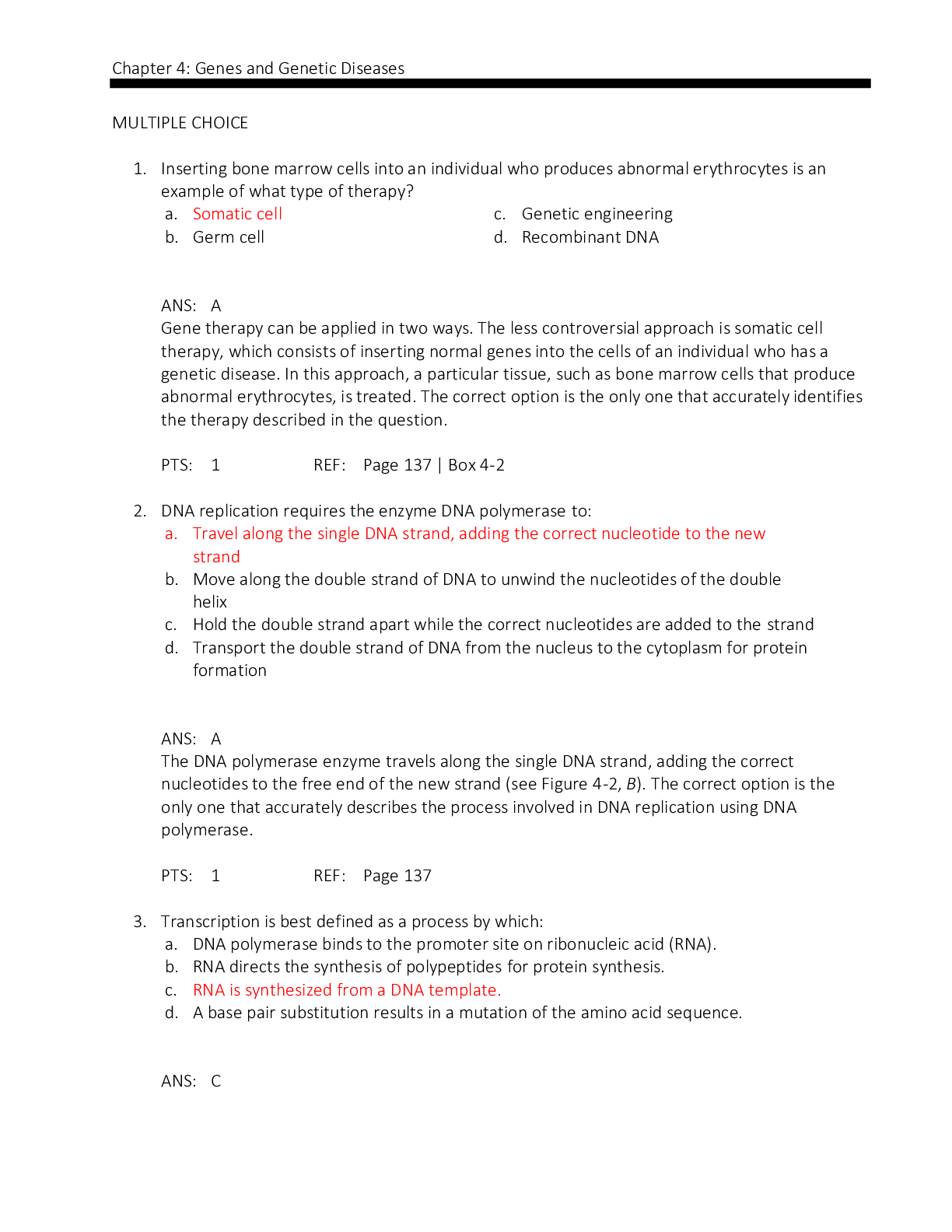
Reviews( 0 )
Document information
Connected school, study & course
About the document
Uploaded On
Sep 06, 2019
Number of pages
26
Written in
Additional information
This document has been written for:
Uploaded
Sep 06, 2019
Downloads
0
Views
53

